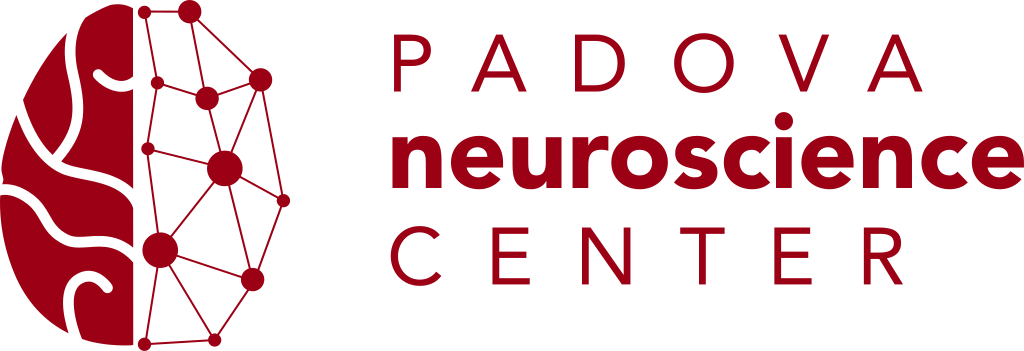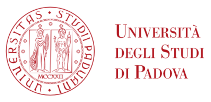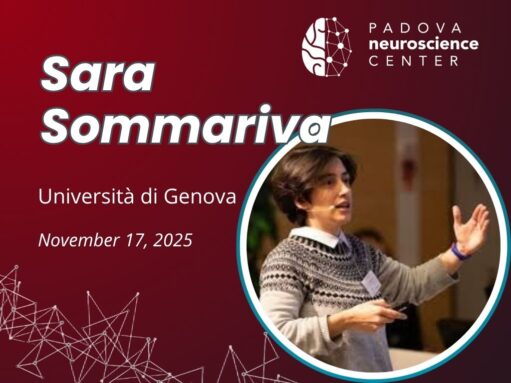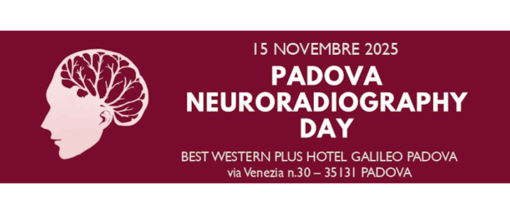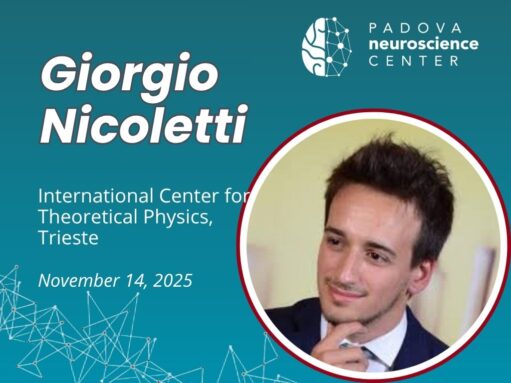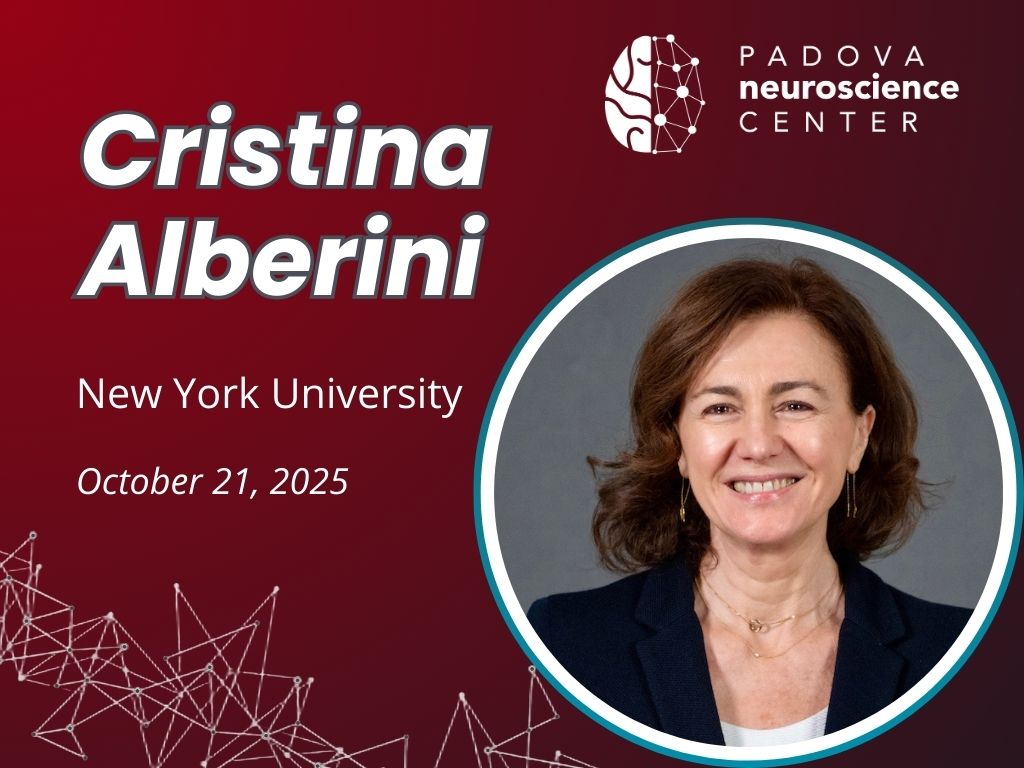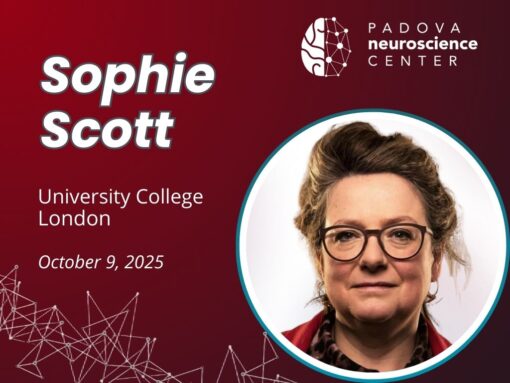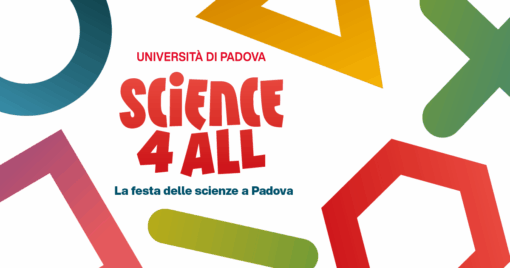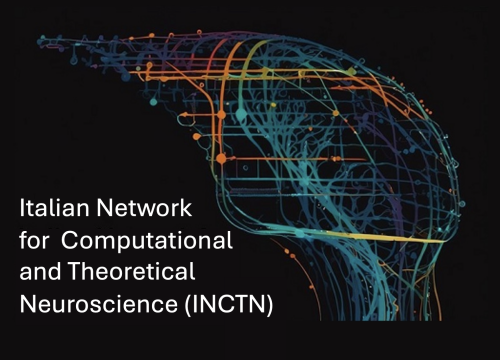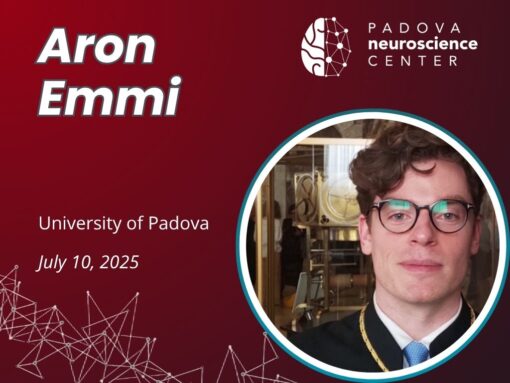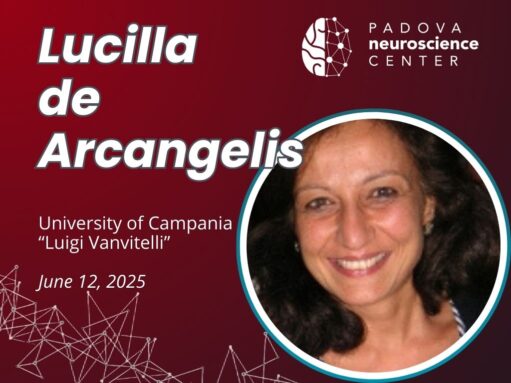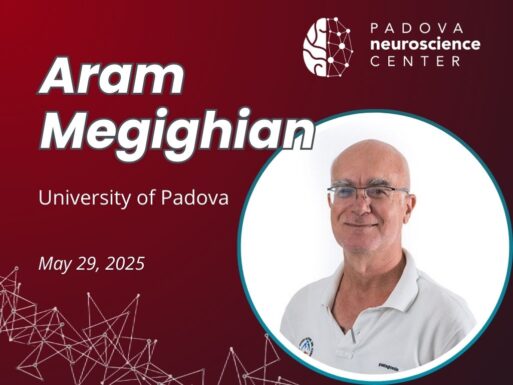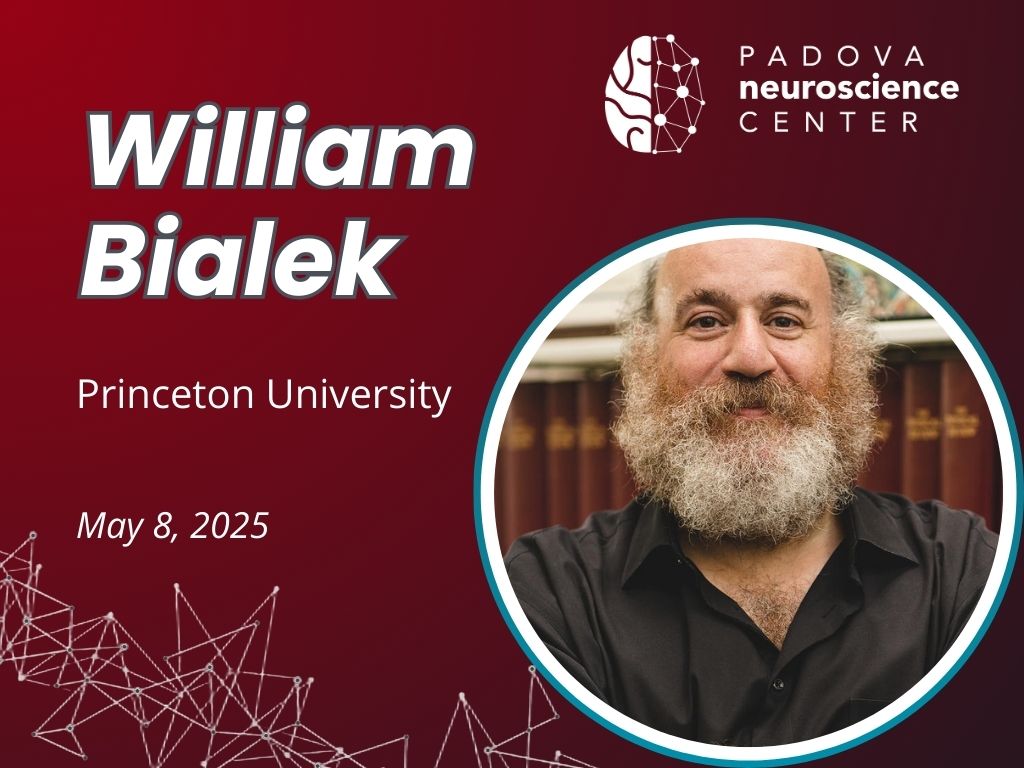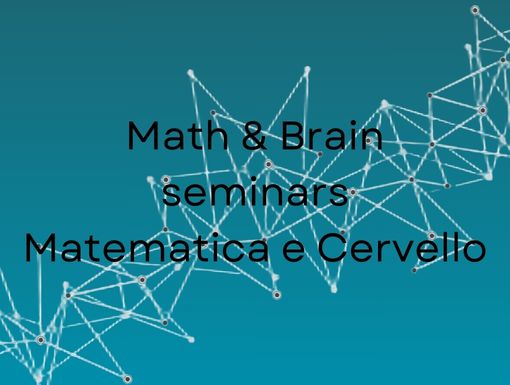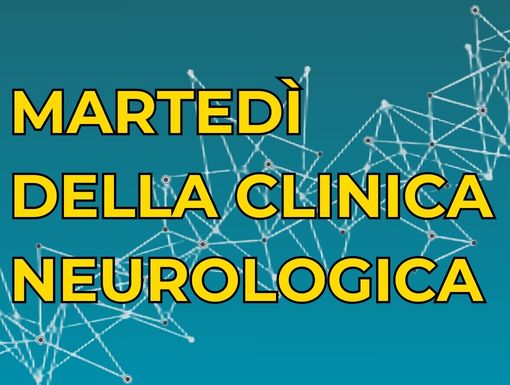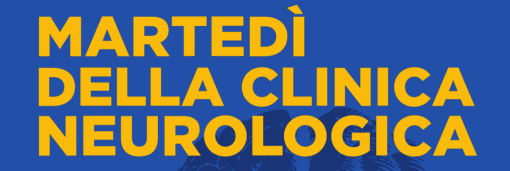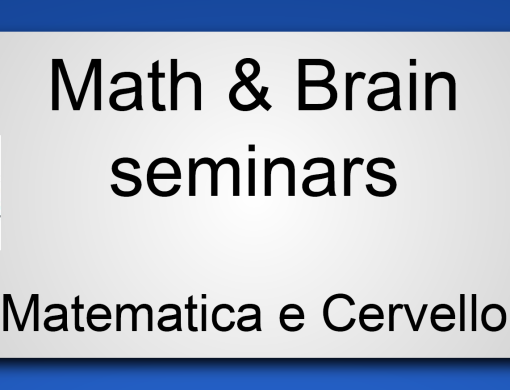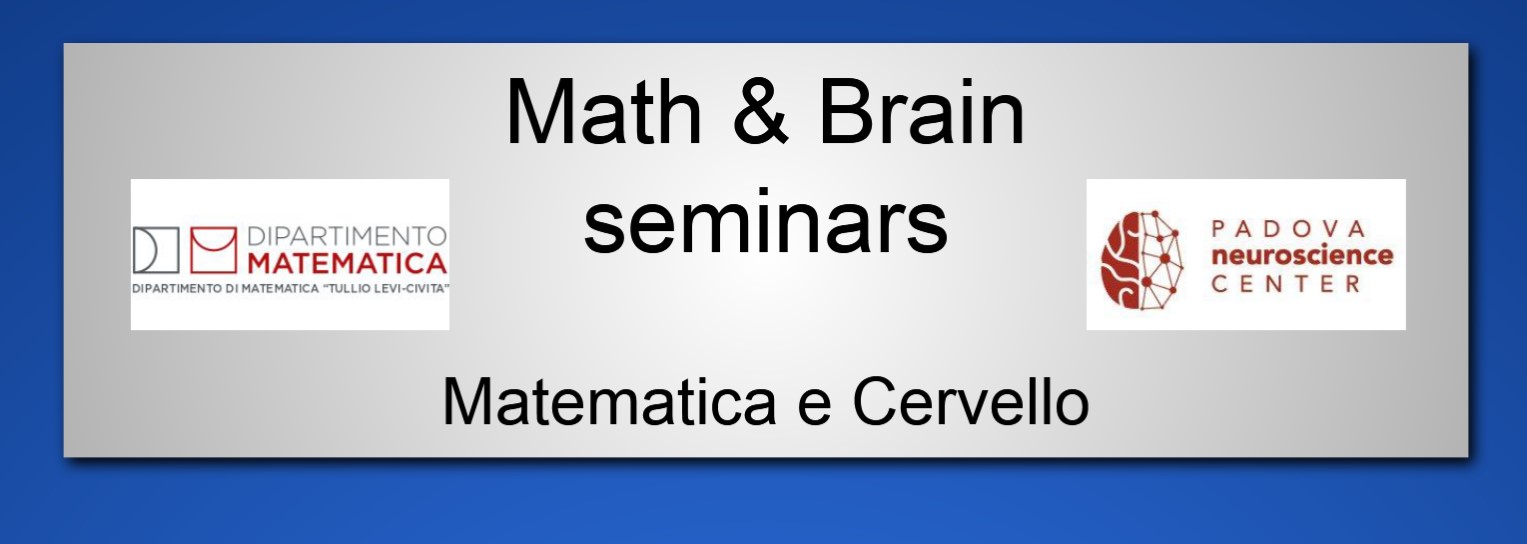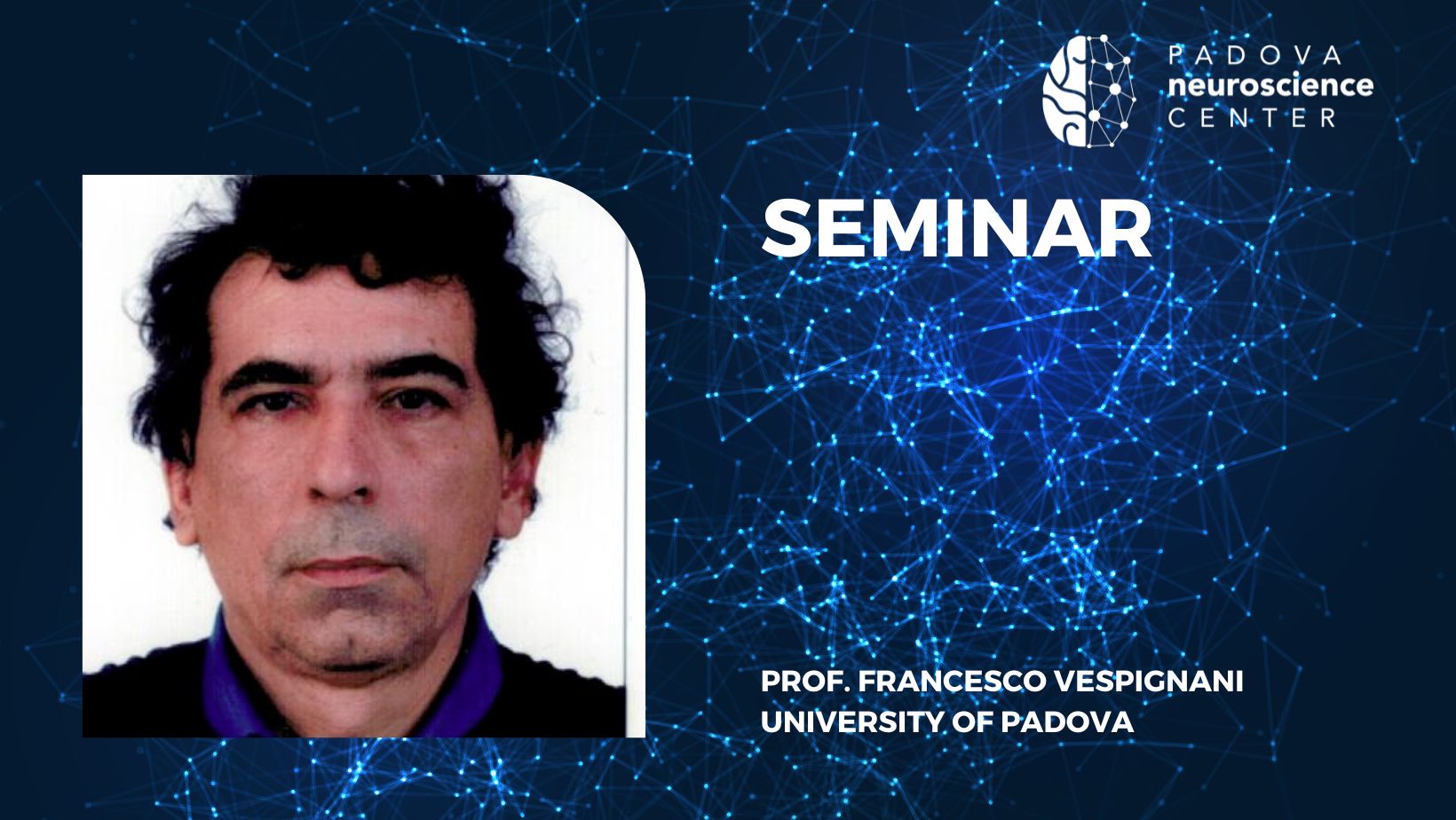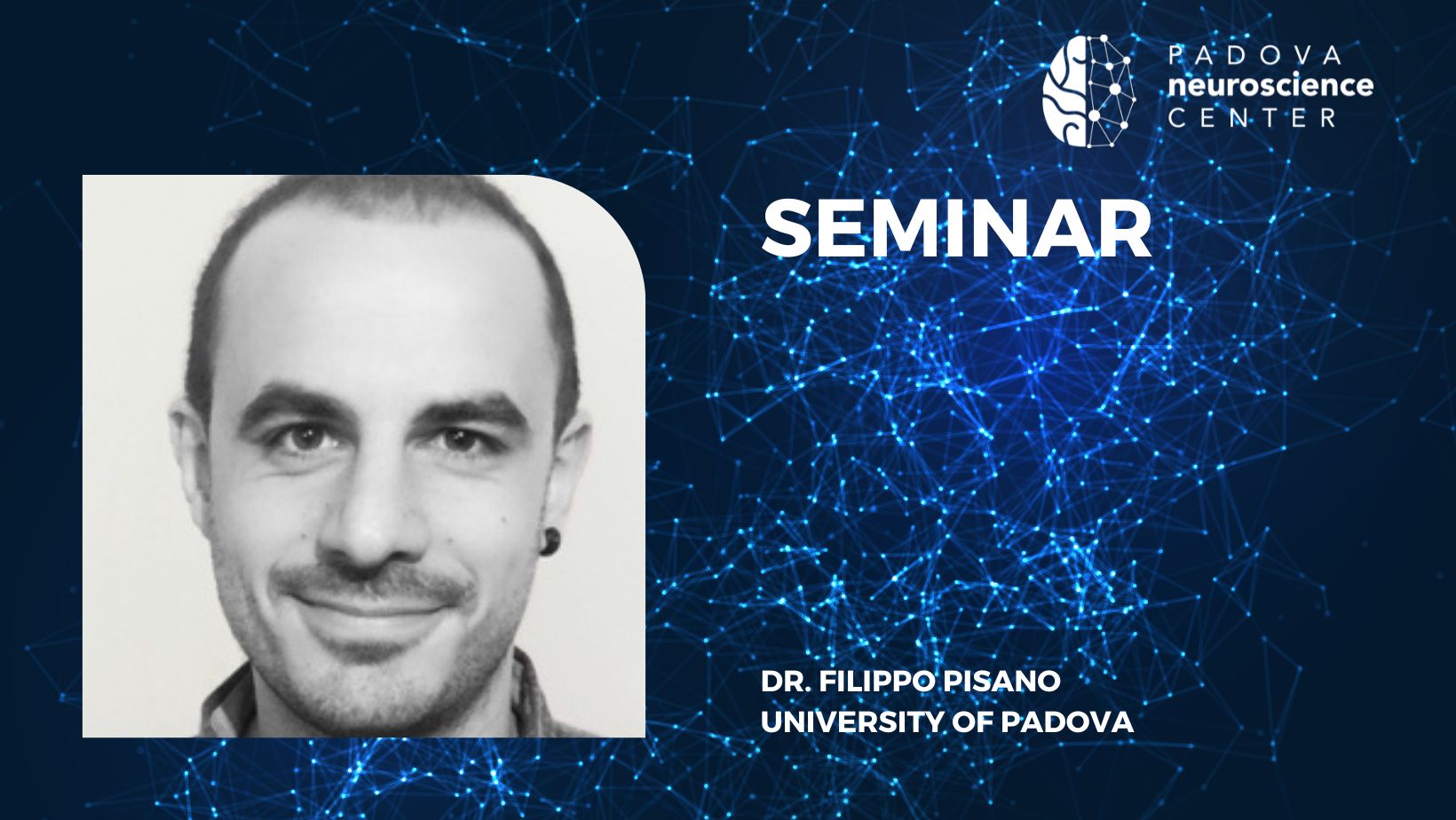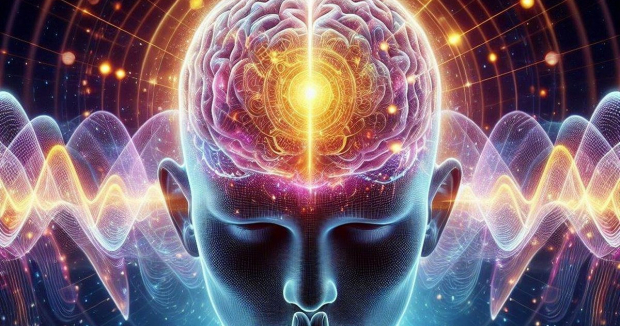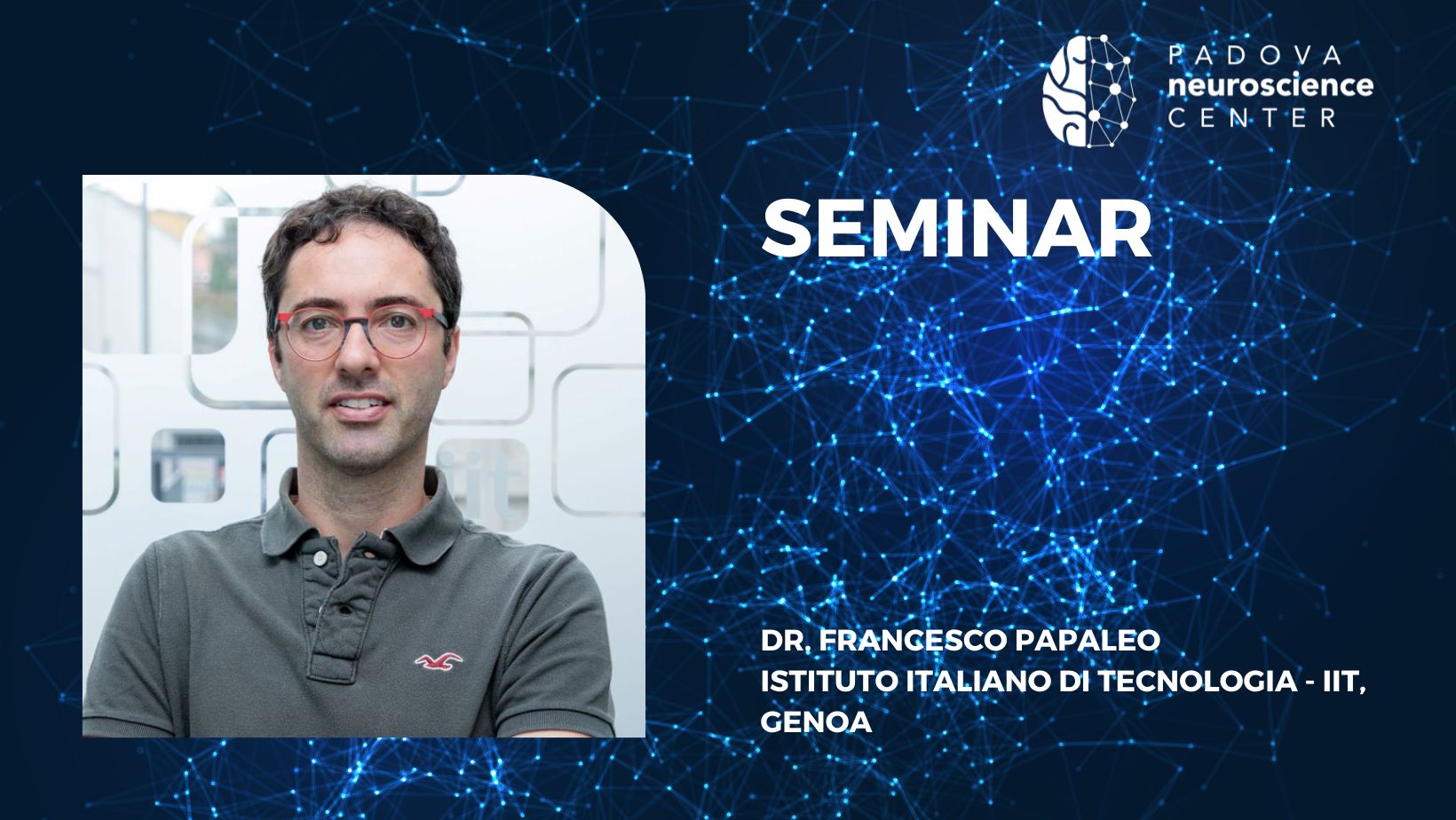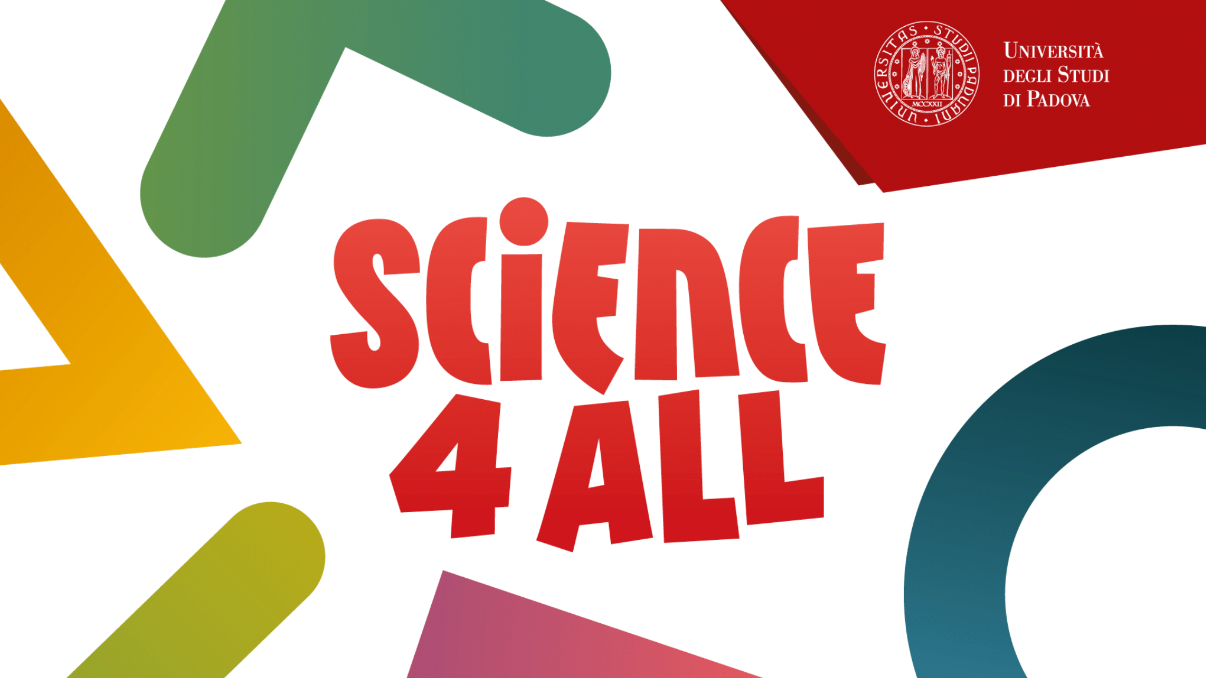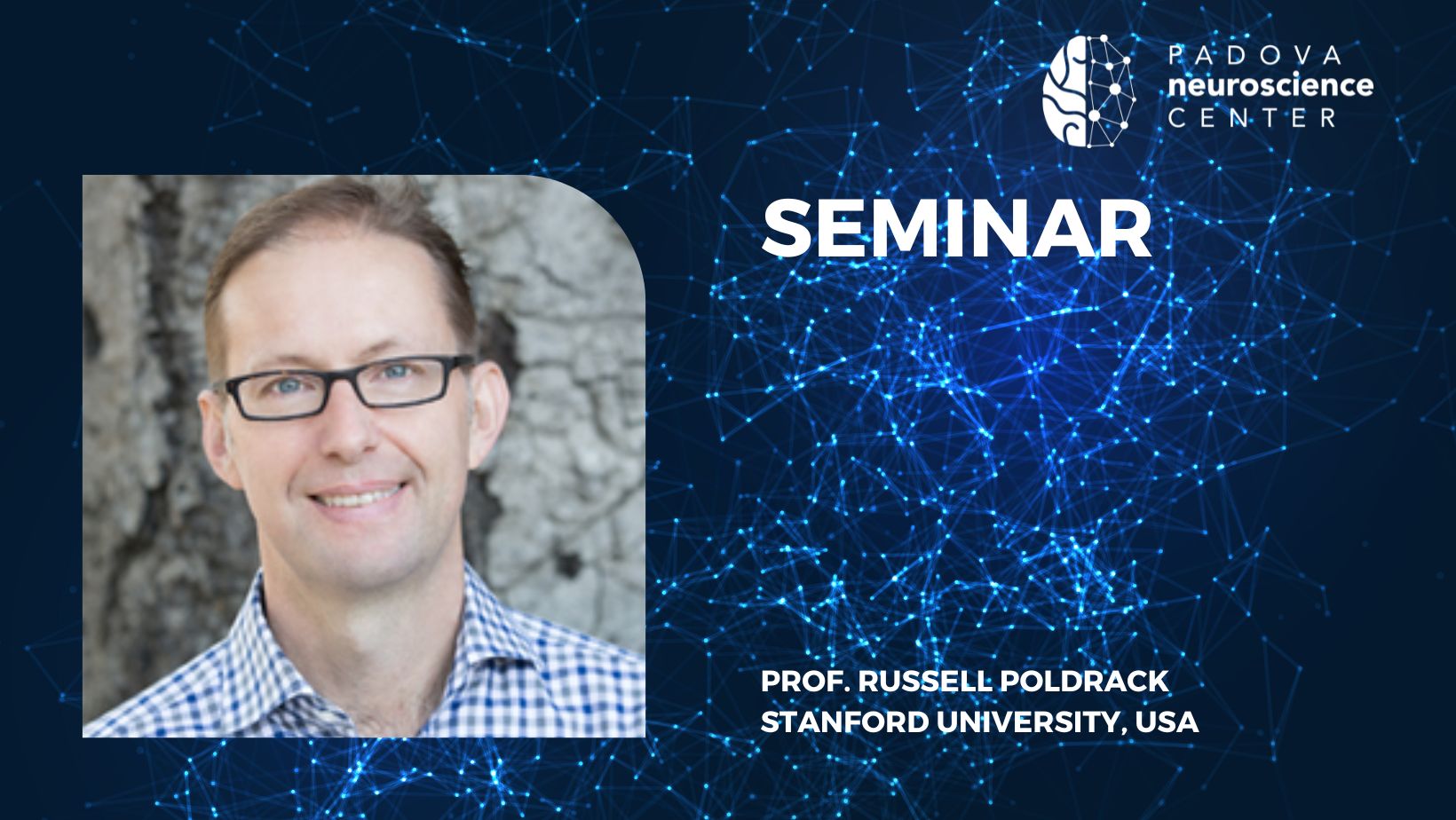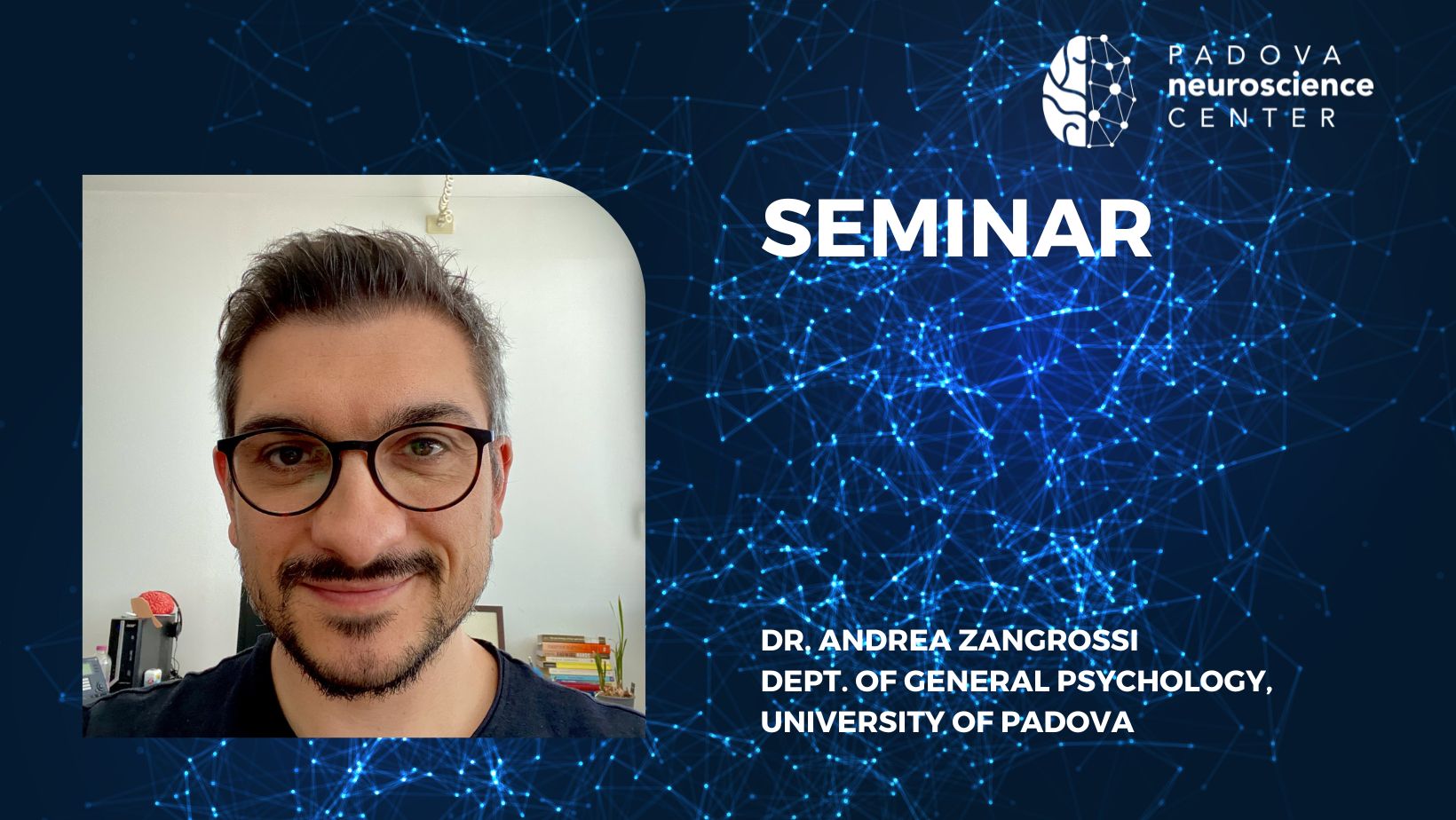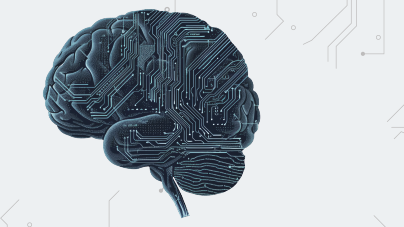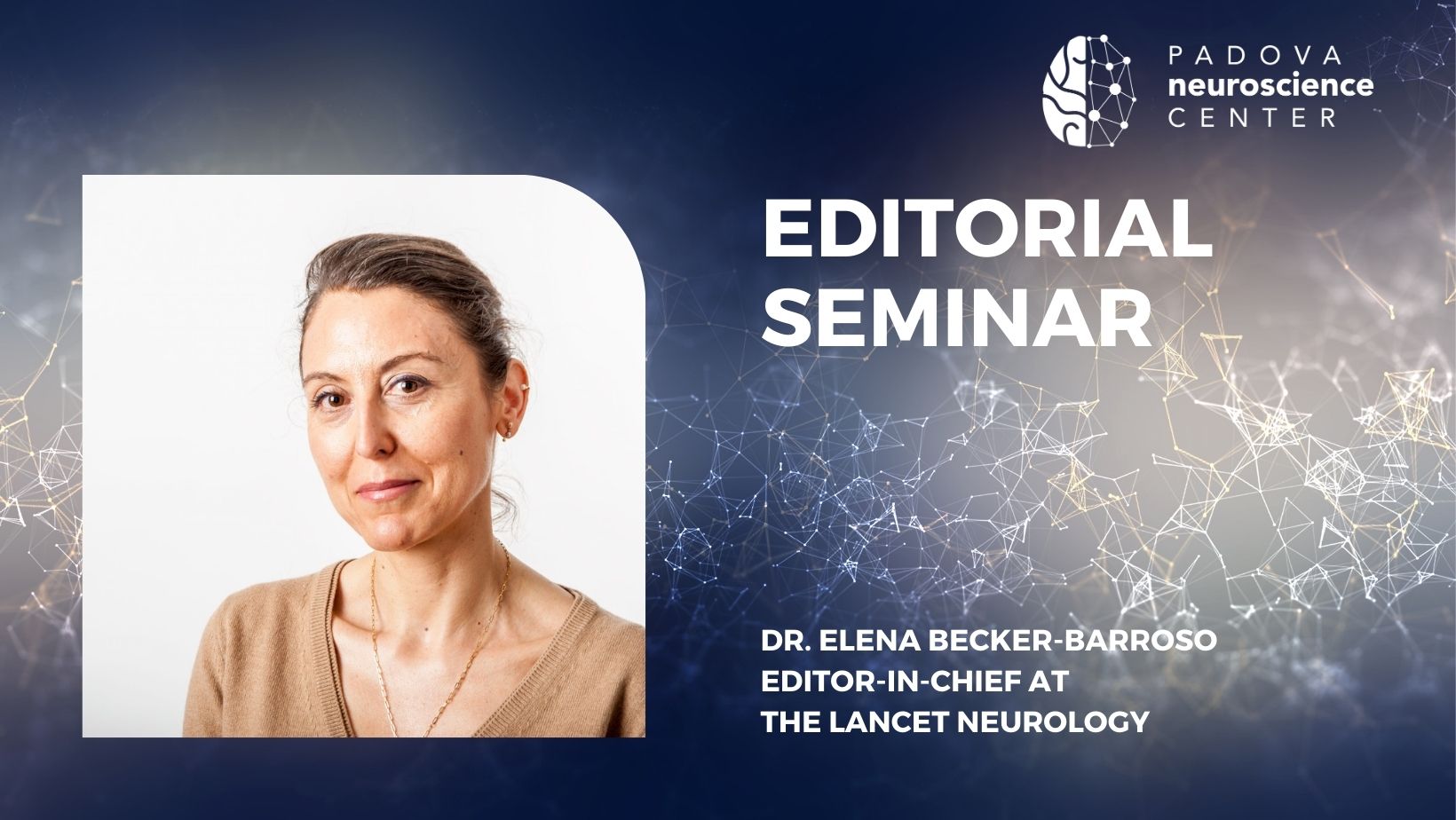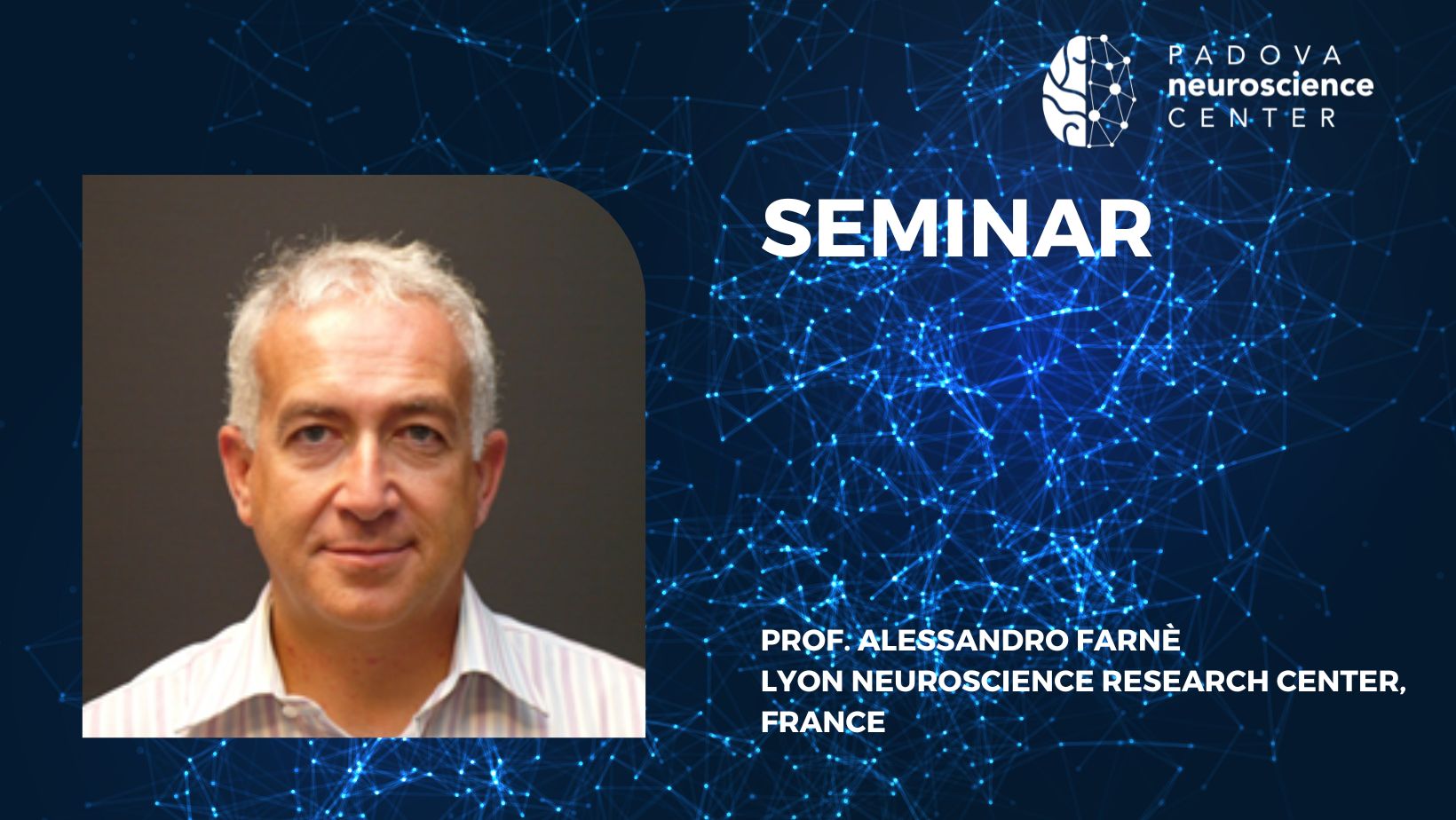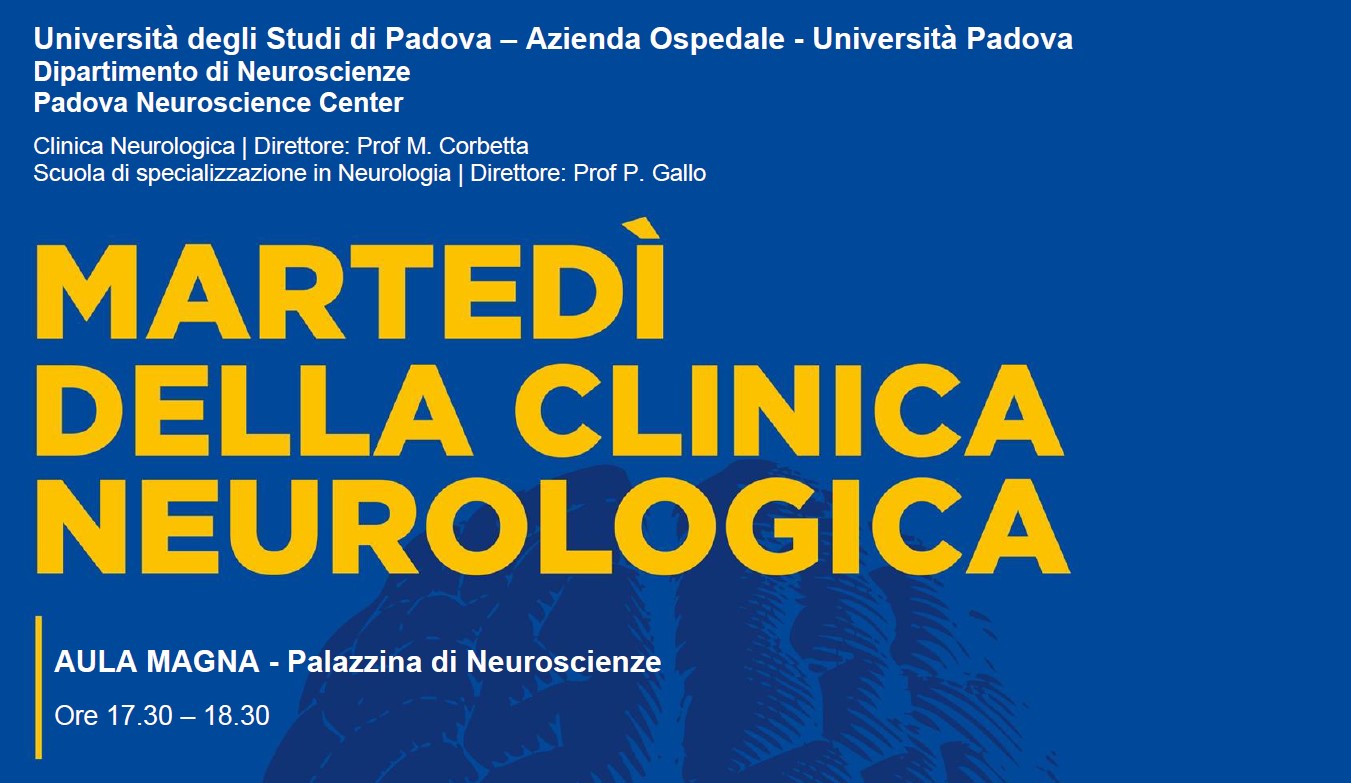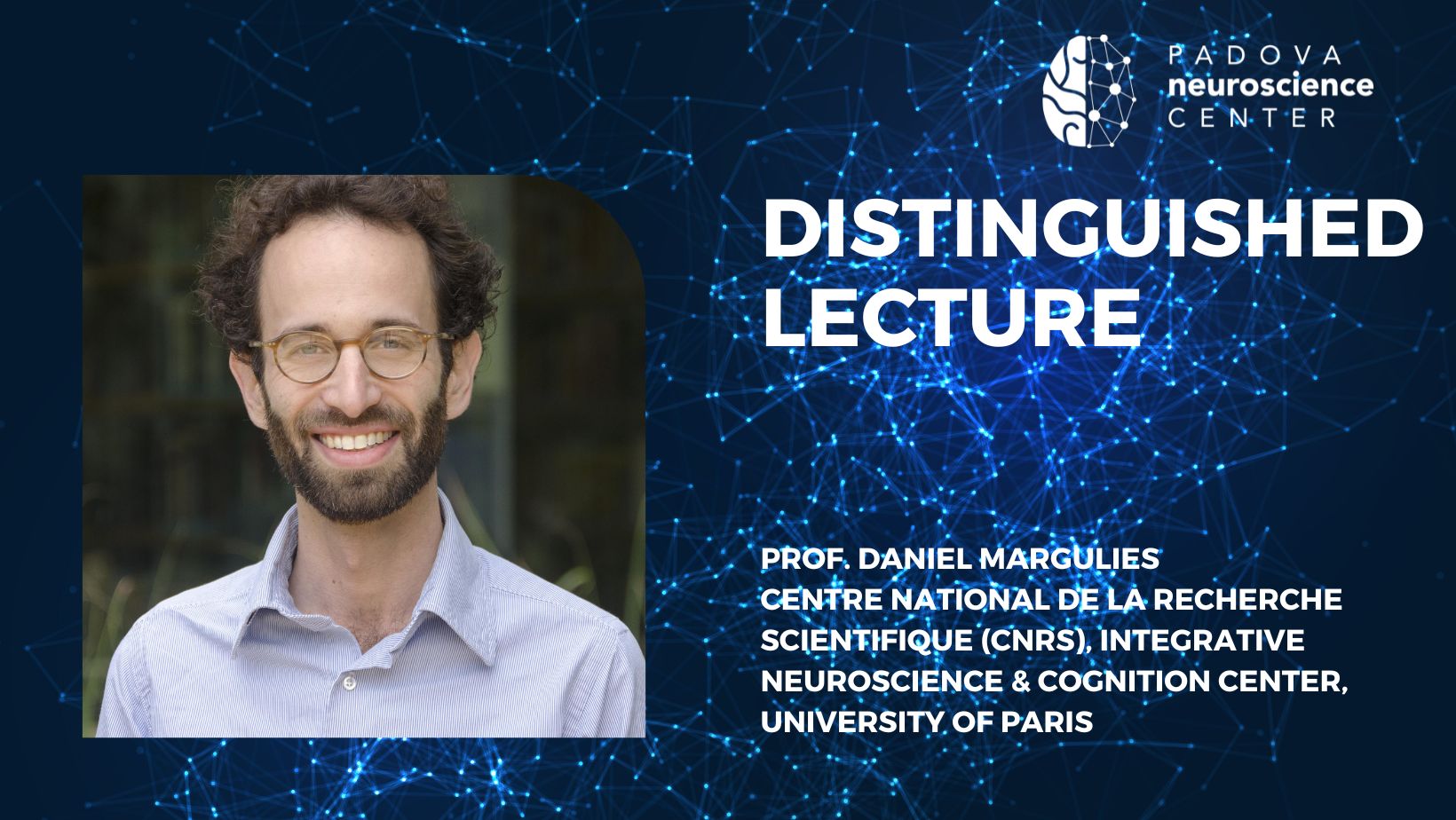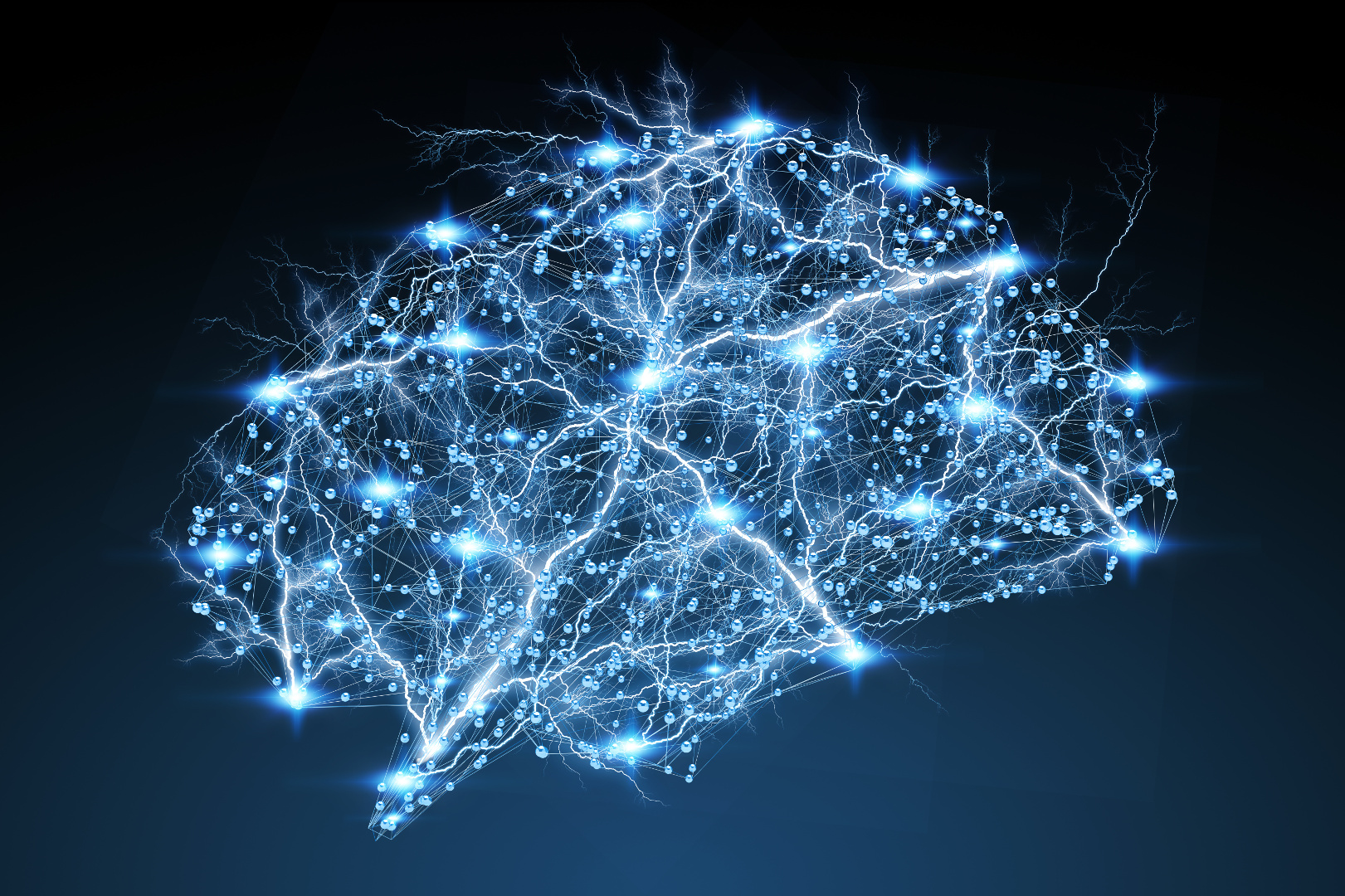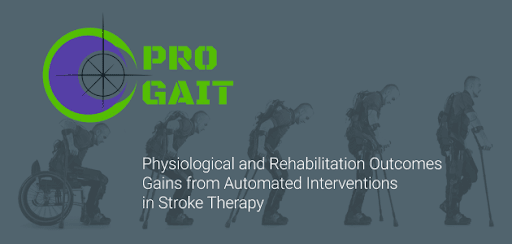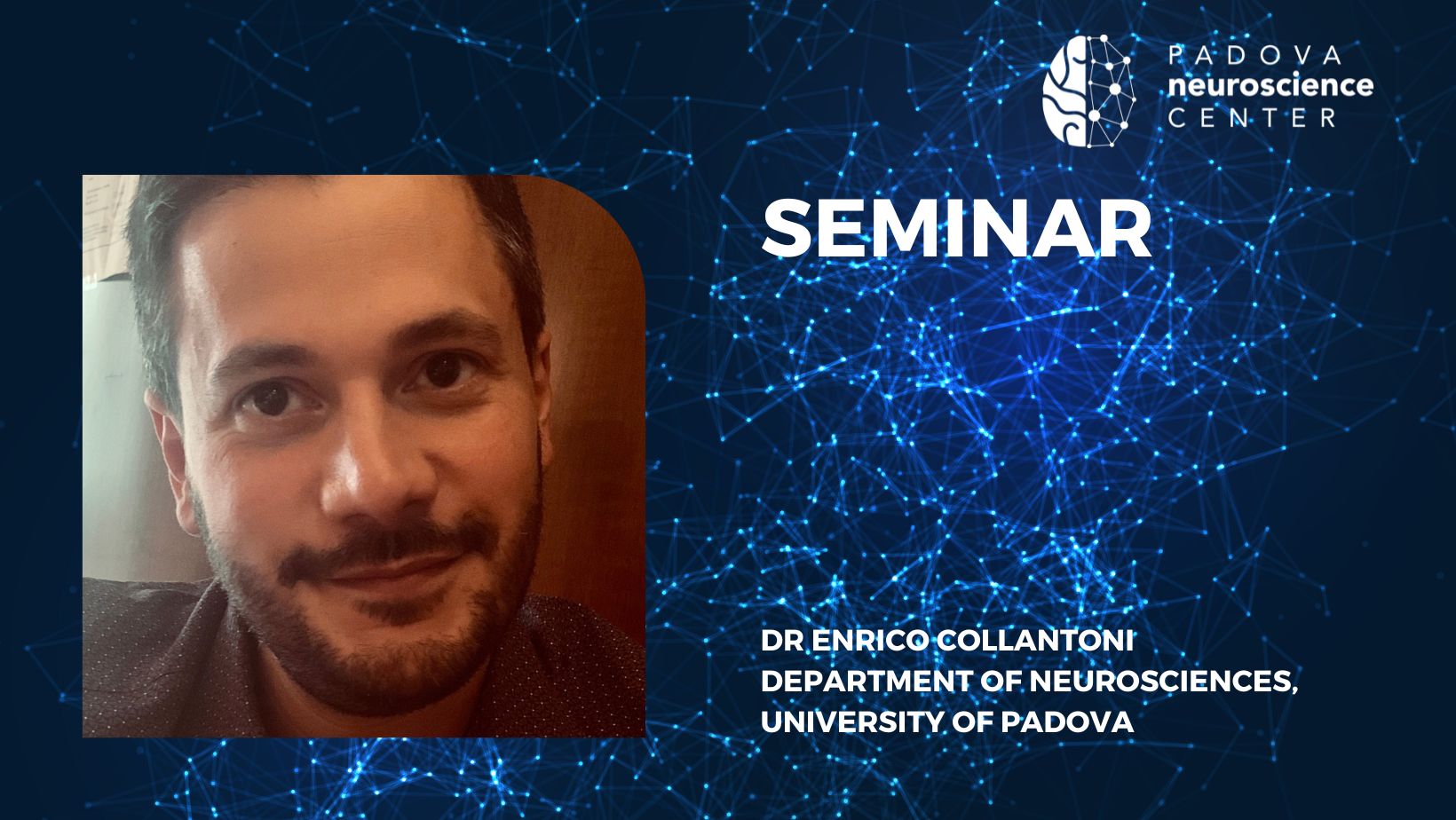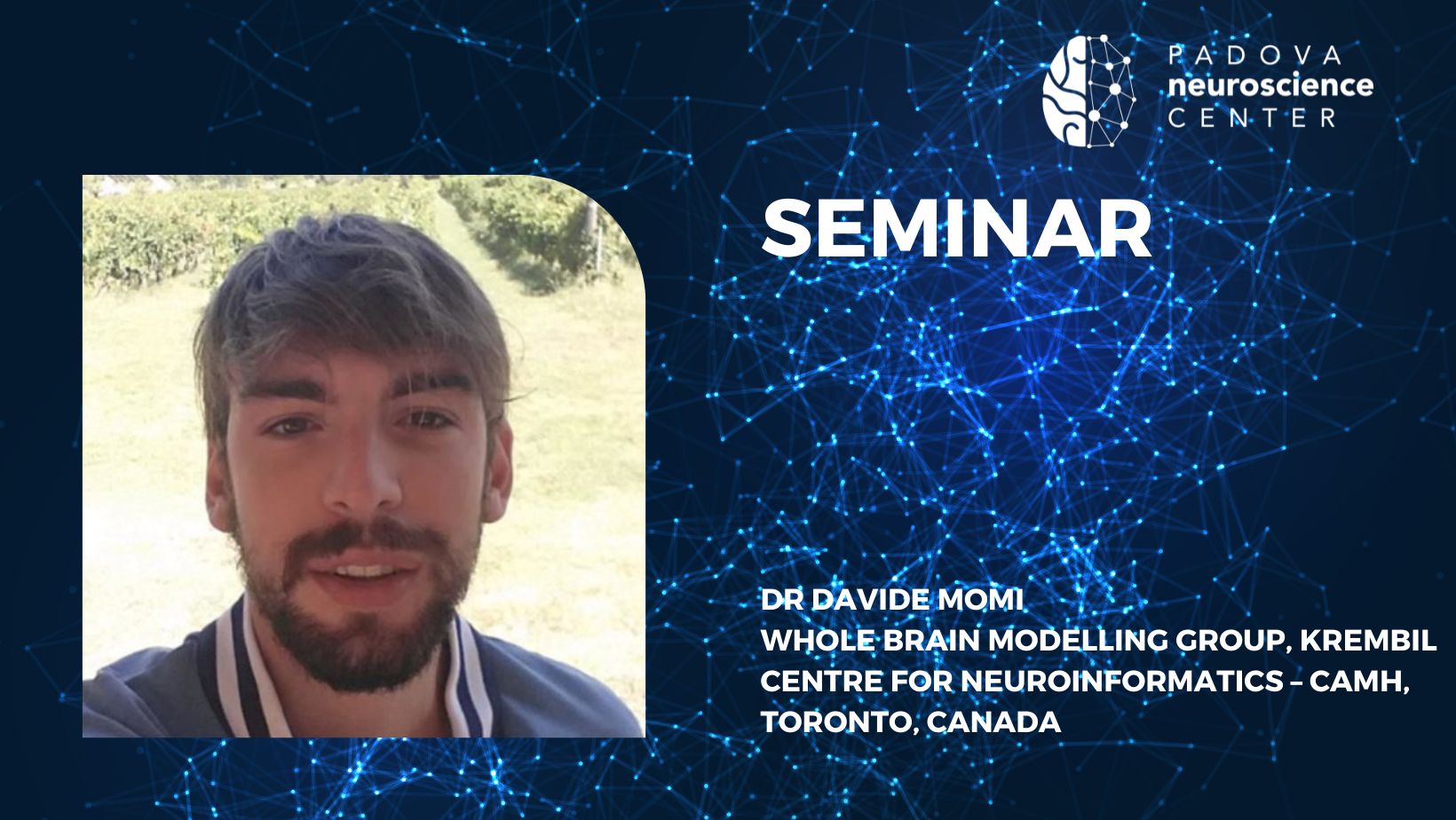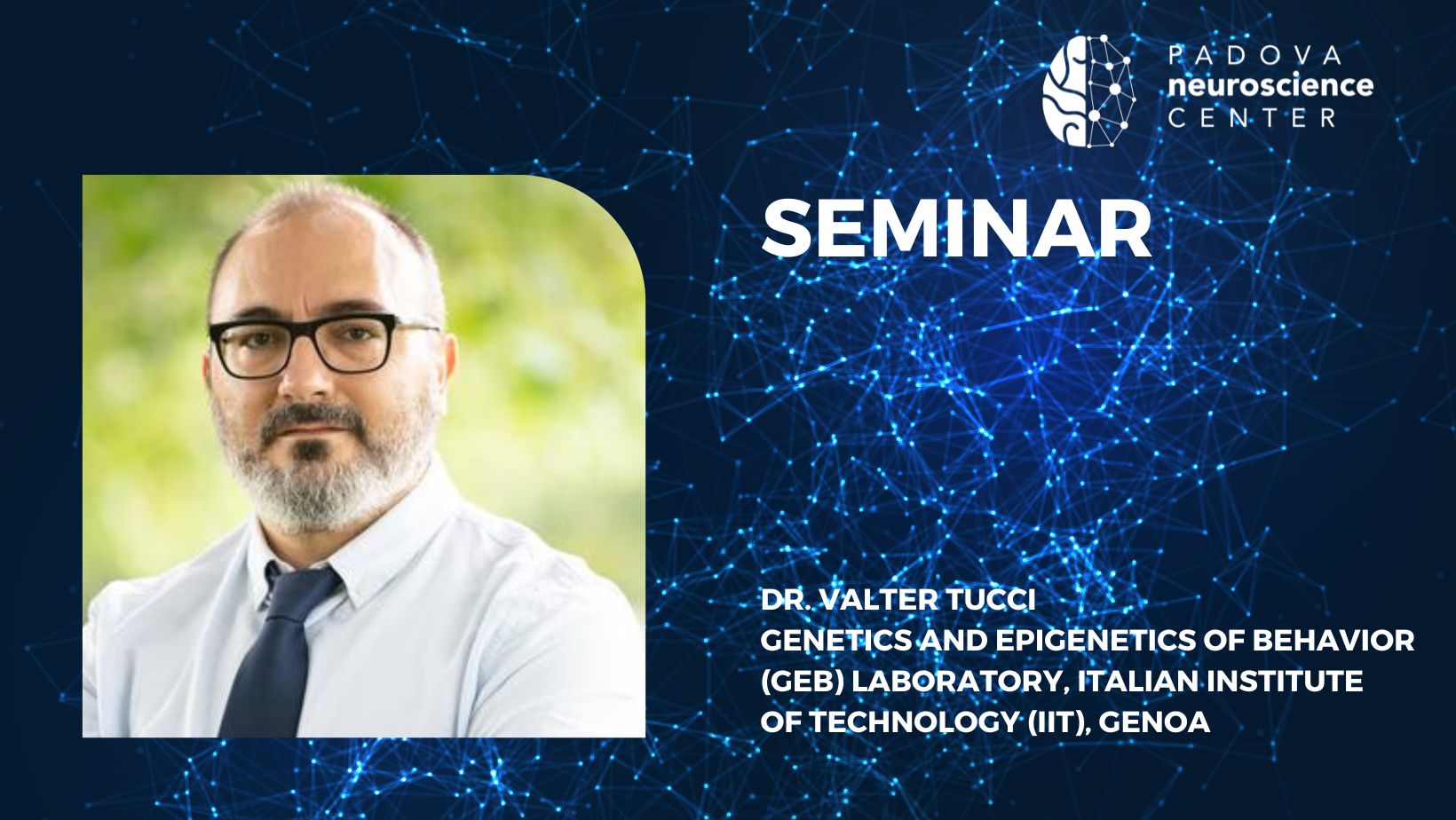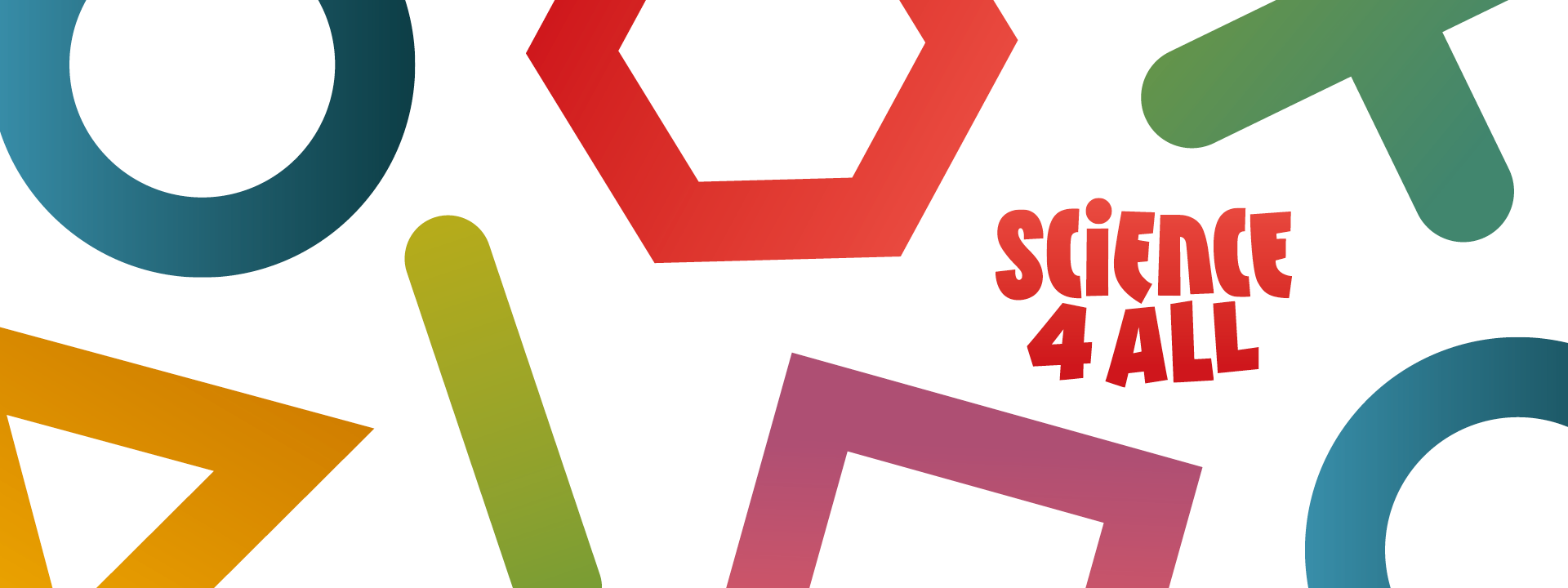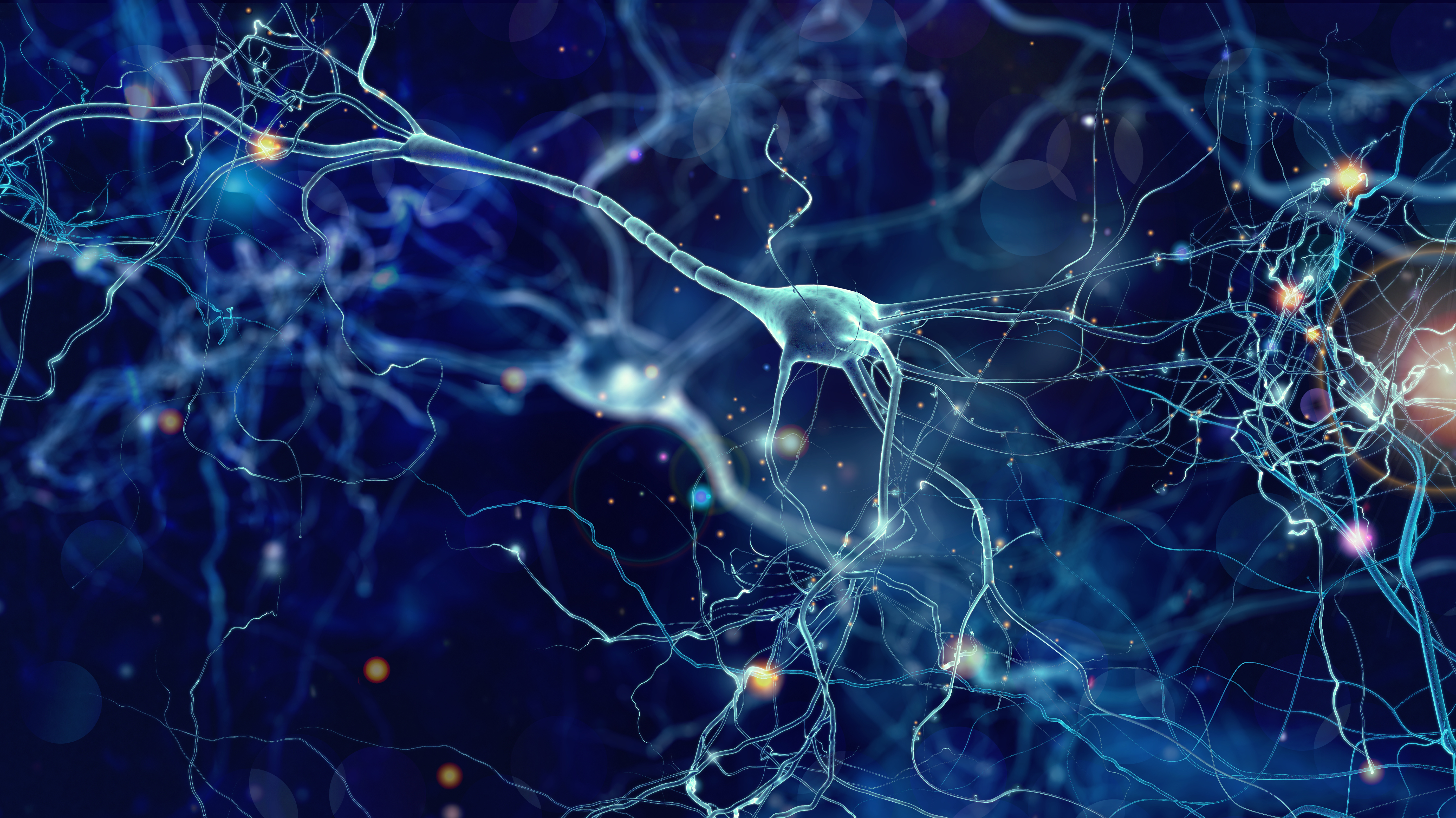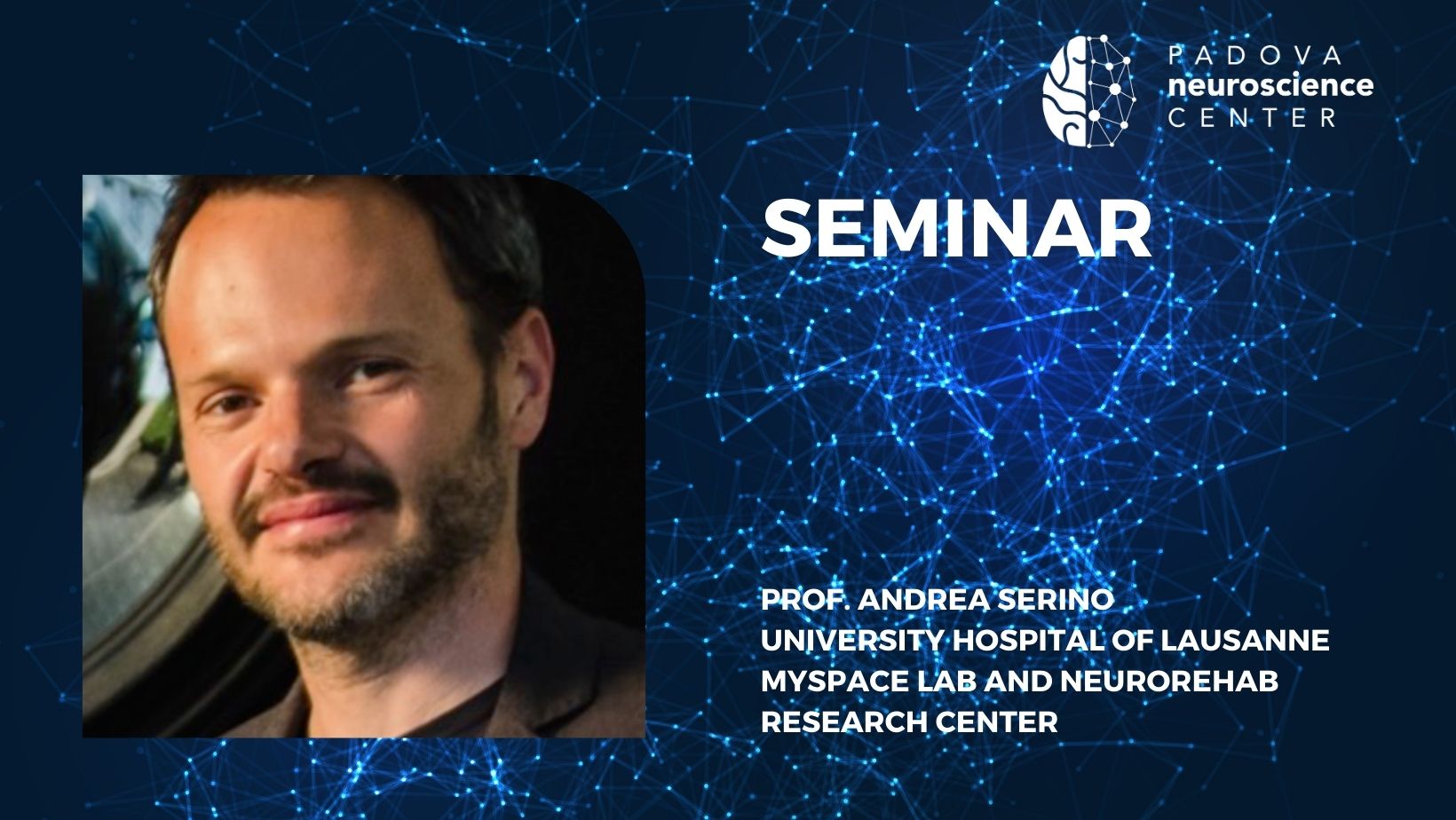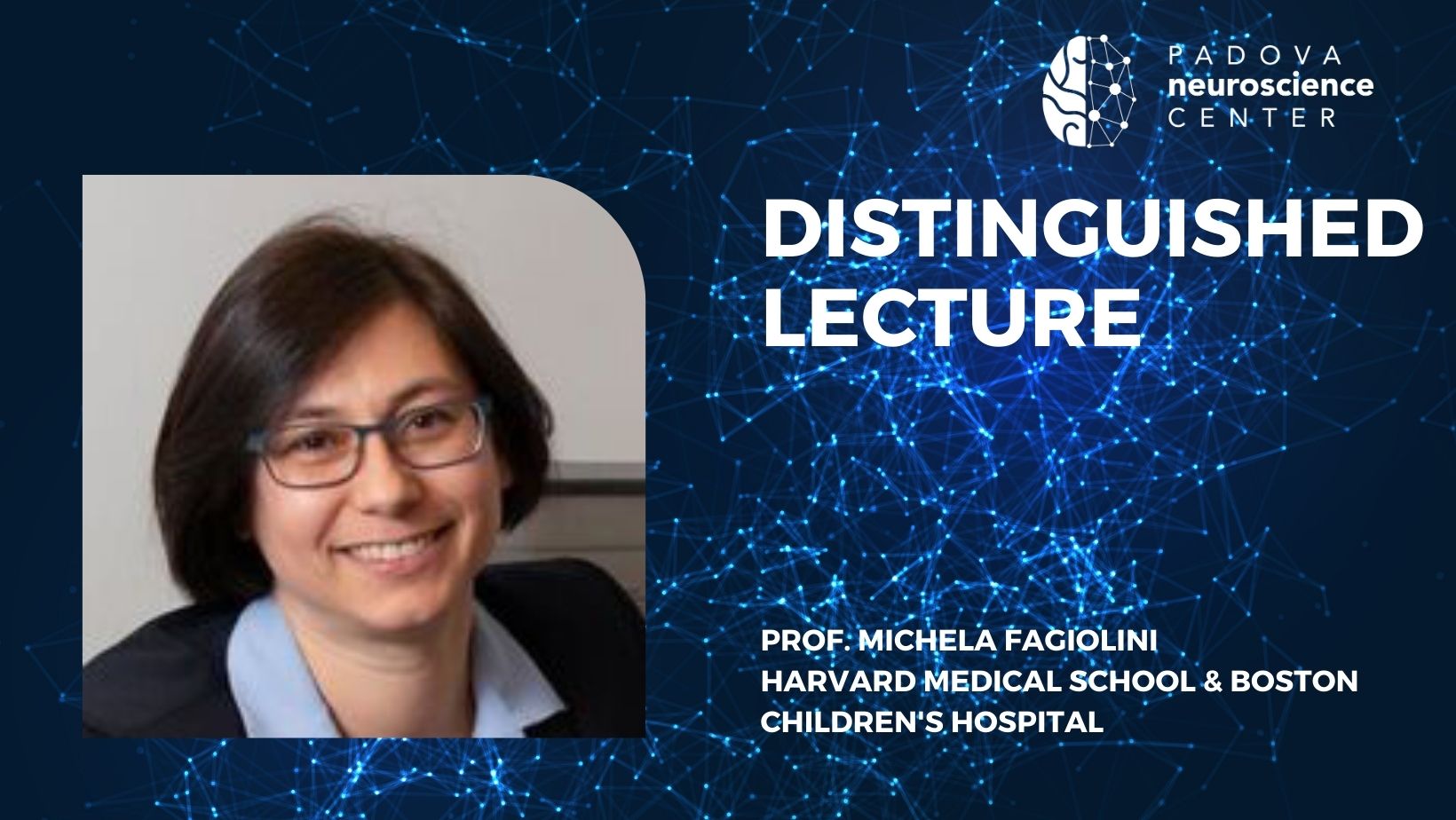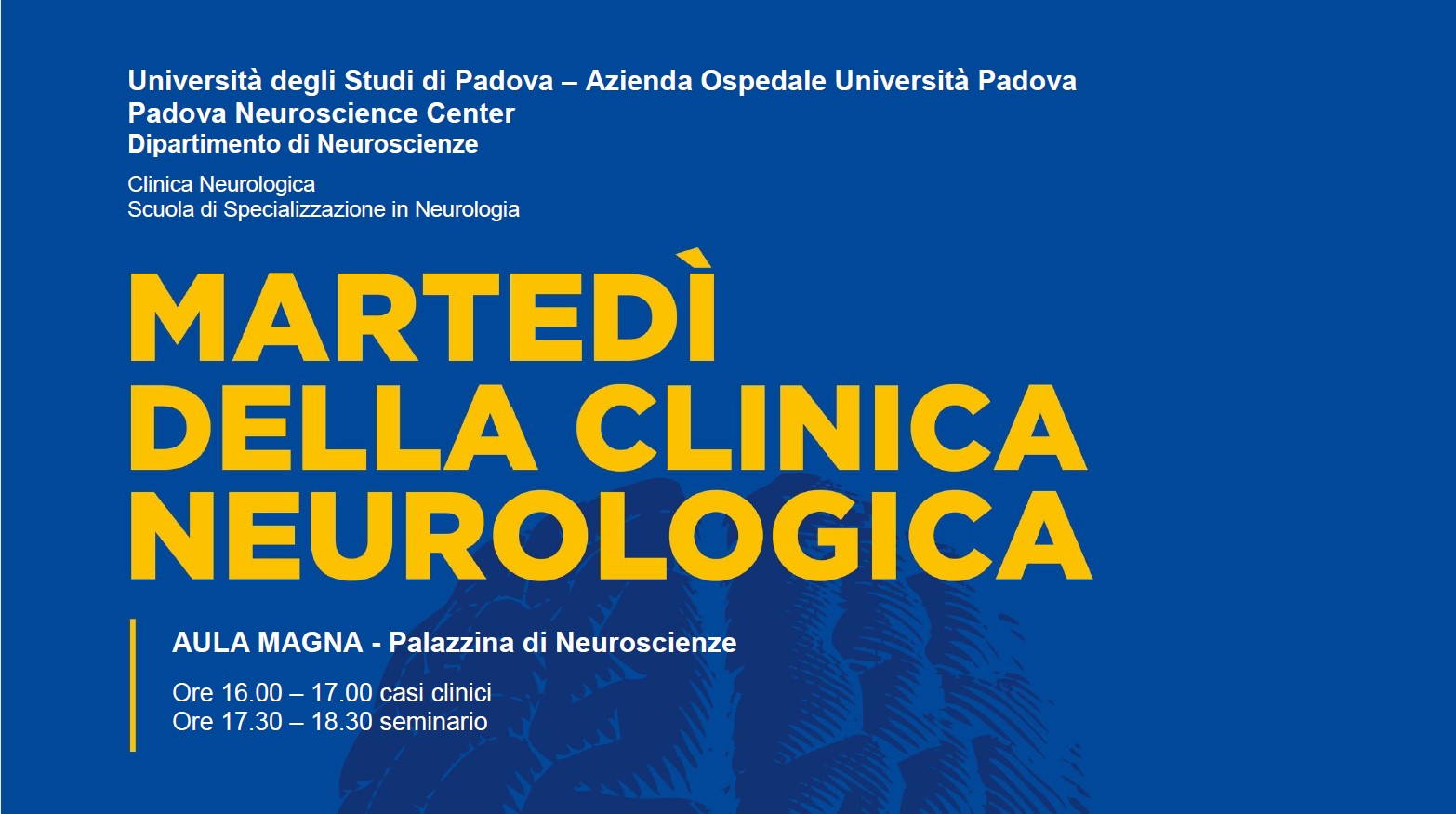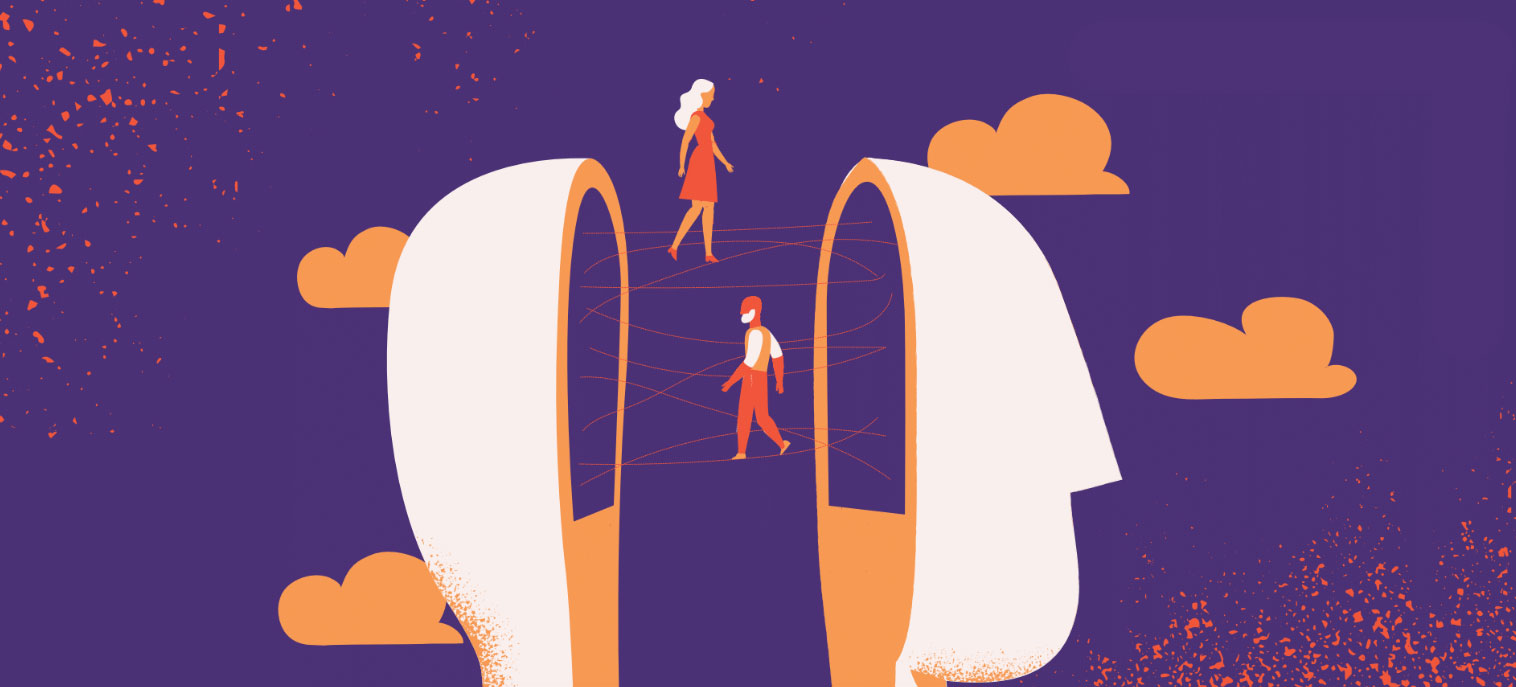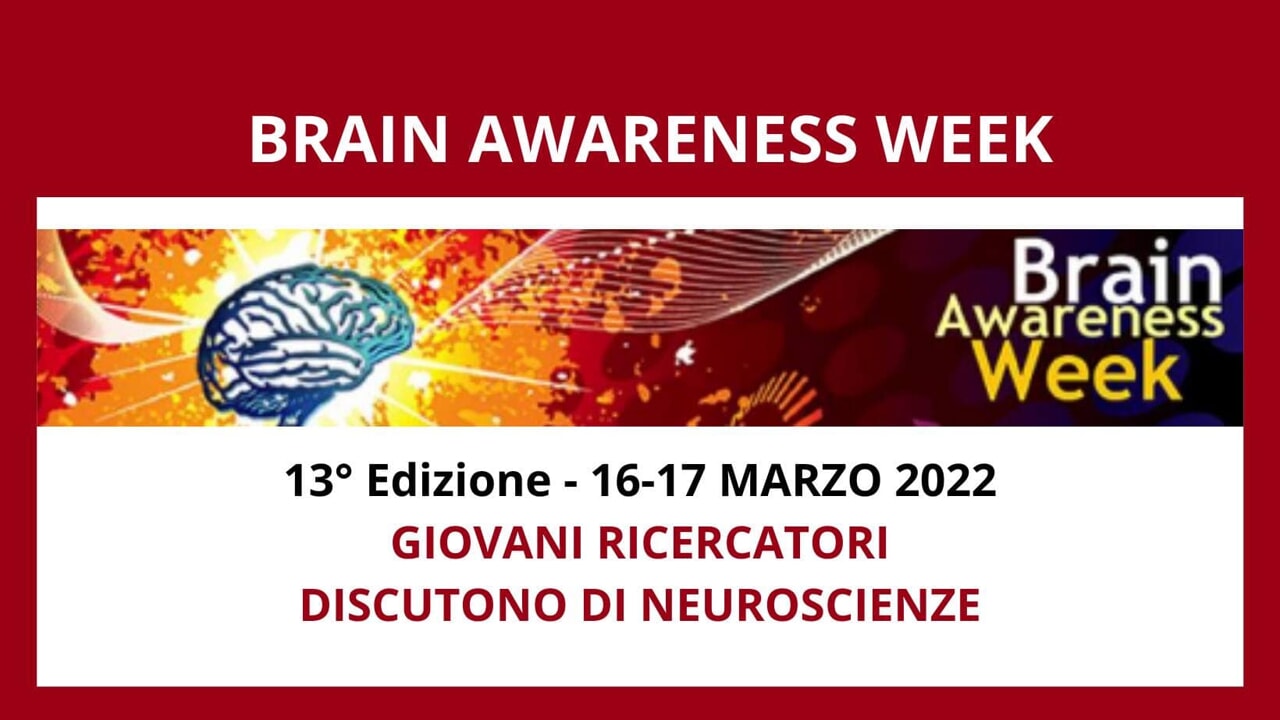Alberto Lovison
Seminar, 2 December 2025
Identify functional connectivity differential graphs in DLB patients
Sara Sommariva
Seminar, 17 November 2025
Padova Neuroradiography Day
Padova Neuroradiography Day
15 November 2025
Decoding behavior
Giorgio Nicoletti
Seminar, 14 November 2025
Imaging the Interaction between Systemic and Brain Immunity
Federico Turkheimer
Distinguished Lecture, 6 November 2025
From bench to bedside
Cristina Alberini
Distinguished Lecture, 21 October 2025
The neurobiology of auditory processing
Sophie Scott
Distinguished Lecture, 9 October 2025
Science4All 2025
Science4All 2025
27-28 September 2025
Conference of the Italian Network for Computational and Theoretical Neuroscience (INCTN), 2nd edition
Conference of the Italian Network for Computational and Theoretical Neuroscience (INCTN), 2nd edition
22-24 September 2025
Parkinson’s Disease: beyond motor symptoms
Dr. Aron Emmi
Seminar, 10 July 2025
On the relation between spontaneous and stimulated activity for the brain in healthy and pathological states
by Prof. Lucilla de Arcangelis, University of Campania “Luigi Vanvitelli”
When: June 12, 2025, at 3:30 pm
Where: Sala Seminari VIMM (Fondazione per la Ricerca Biomedica Avanzata Onlus, Via Orus 2, Padova)
Abstract: The fundamental open question of the relation between spontaneous and evoked activity is a longstanding question in neuroscience. Here we formalize it by means of the stochastic Wilson Cowan model.
An approach inspired in non-equilibrium statistical physics allows to calculate fluctuation-dissipation relations, suggesting that measurements of the spontaneous fluctuations in the global brain activity could provide a prediction for the system response to a stimulus. Theoretical predictions are in good agreement with MEG data for healthy patients performing visual tasks. In pathological conditions the relations still hold and evidence a complex oscillatory behavior in the temporal correlations. The analysis of the entropy production in a range of parameters near the critical point suggests that the system is always out of equilibrium and that the entropy production is minimized if the balance of excitation and inhibition is realized.
The history of vestibular research in Padova before the famous school of Prof M. Arslan
Prof. Aram Megighian
PNC Seminar, 29 May 2025
Thinking about thousands of neurons
Prof. William Bialek
Distinguished Lecture, 8 May 2025
The Bayesian Mind: Perceiving the World is an Inference Problem
Dr. Ambra Ferrari
Math & Brain Seminar, 17 April 2025
Tranceformation: Hypnosis in Mind, Brain and Body
Prof. David Spiegel
Distinguished Lecture, 17 April 2025
Biomarkers innovativi nella SLA
Prof. Pietro Fratta
Martedì della Clinica Neurologica, 1 April 2025
Disautonomia nei Parkinsonismi
Martedì della Clinica Neurologica, 25 March 2025
Continue readingWhole brain model for neural activity at criticality
Prof. Samir Suweis
Math & Brain Seminars, 18 March 2025
Update sui nuovi criteri di sclerosi multipla
Prof. Massimo Filippi
Martedì della Clinica Neurologica, 18 March 2025
Connectomic view of neuro-oncology and neuro-surgical implications
Relatore: Prof. Hugues Duffau, Centre Hospitalier Universitaire de Montpellier, Francia
Quando: 18 febbraio 2025 alle ore 17:30
Dove: Aula Magna della Clinica Neurologica oppure online su piattaforma Zoom (https://unipd.zoom.us/j/88122453021)
Stato epilettico nell’adulto: Trattamento generale e dei casi “de novo”
Relatore: Dott.ssaMonica Ferlisi, AOUI Verona
Quando: 11 febbraio 2025 alle ore 17:30
Dove: Aula Magna della Clinica Neurologica oppure online su piattaforma Zoom (https://unipd.zoom.us/j/88575019107)
La neurogenetica dei disturbi del movimento
Relatore: Prof.ssa Miryam Carecchio, Università di Padova
Quando: 4 febbraio 2025 alle ore 17:30
Dove: Aula Magna della Clinica Neurologica oppure online su piattaforma Zoom (https://unipd.zoom.us/j/88575019107)
Towards a circuit-specific cartography and molecular fingerprinting of synaptic plasticity
by Prof. Marco Mainardi, University of Padua
When: January 30, 2025, at 3:00 pm
Where: Sala Seminari VIMM (Fondazione per la Ricerca Biomedica Avanzata Onlus, Via Orus 2, Padova)
Abstract: Information storage in the brain, as well as adaptation of neural circuits to external stimuli, rely on restless rearrangement of synaptic connections. Moreover, synapses adjust their strength by varying their molecular composition. Despite the obvious importance of these phenomena, the use of specific tools to study them has been sporadic. Appropriate genetically encoded reporters and probes can help to fill this gap in terms of both imaging and determination of the molecular composition of synapses.
During my talk, I will discuss my most recent effort in this regard, which are based on the in vivo use of recombinant proteins for synapse visualization and for the isolation of the synaptome in specific activation states.
By using behavioral paradigms of hippocampus-dependent learning, my results contribute to elucidate whether specific hotspots for synaptic plasticity exist and to determine the changes in the molecular composition of synapses that support learning and memory.
Update sulla genetica e le terapie delle malattie neuromuscolari
Relatore: Dott. Andrea Cortese, University College of London (UCL)
Quando: 28 gennaio 2025 alle ore 17:30
Dove: Aula Magna della Clinica Neurologica oppure online su piattaforma Zoom (https://unipd.zoom.us/j/88575019107) 2025-01-28 – Andrea Cortese
La neurologia del futuro: dal “brain health” alla complessità
Relatore: Prof. Alessandro Padovani, Università degli Studi di Brescia
Quando: 21 gennaio 2025 alle ore 17:30
Dove: Aula Magna della Clinica Neurologica
Theoretical neuroscience: the geometry and dynamics of behavior, cognition, and learning
Speaker: Prof. Luca Mazzucato (Institute of Neuroscience, University of Oregon, USA)
When: 11 December 2024, h. 5:30 pm
Where: 1AD100, Torre Archimede
Abstract: Recent years have brought tremendous progress in the fields of artificial intelligence and neuroscience, however, a comprehensive framework to explain the computational principles of complex cognitive function and flexible behavior is still lacking. Addressing the complexity within large-scale, multi-area neuronal recordings with simultaneous monitoring of behavioral variables demands novel and deeper connections between the different axes of theoretical neuroscience. In this talk, I will review current approaches and highlight challenges in the upcoming NeuroAI field with particular focus on the following questions: i) What kind of dynamical systems can explain the complex spatiotemporal features of naturalistic animal behavior? ii) What new physical ingredients should recurrent neural networks incorporate to explain the richness observed in large-scale neural activity during behavior? iii) What is the geometry of neural representations in animal brains and how is it related to the geometry of deep learning? Finally, I will show some recent work in my lab showing how the optimal cognitive function known as the Yerkes-Dodson law of psychology relies on a phase transition occurring in sensory cortical circuits.
Rhythms, entrainment, prediction, and repetition: what is special about language and the brain?
by Prof. Francesco Vespignani, University of Padova
When: November 28, 2024, at 3:00 pm
Where: Sala Seminari VIMM (Fondazione per la Ricerca Biomedica Avanzata Onlus, Via Orus 2, Padova)
Abstract: Cognitive science of language has been dominated for decades by innatism based on generative grammar theory. More recent years have seen a renaissance of models based on (statistical) learning only, leading to positions which I dub neo-behavioralist. These positions are recently even more popular, partially boosted by recent developments of AI large language models. Within this debate, prediction and sensitivity to rhythmicity and regularities of language play a significant role in models of language processing, tightly linked to theories of system neurosciences. I will present some of my current research on prediction, repetition, and entrainment in language processing at the sentence level. I will also try to persuade the audience that it is time to abandon strict ideological position on nature/nurture dualism.
Harnessing light in deep brain regions for multimodal optical neural recordings through thin fiber probes
by Dr. Filippo Pisano, University of Padova
When: November 14, 2024, at 3:00 pm
Where: Sala Seminari VIMM (Fondazione per la Ricerca Biomedica Avanzata Onlus, Via Orus 2, Padova)
Abstract: Over the past two decades, a versatile technological framework combining optical methods with genetically encoded molecular reporters has opened unprecedented opportunities for monitoring neural activity in the living mouse brain. These advancements have been accompanied by a growing awareness that a comprehensive investigation of brain function must account for the brain’s multifaceted complexity, including biomolecular changes associated with physiological and pathological dynamics. This seminar will explore the opportunities afforded by a broader perspective on light-brain interactions, presenting a methodology for low-invasive, label-free optical spectroscopy in deep brain regions. This approach can complement existing techniques towards a more complete understanding of neural mechanisms, with potential applications in both fundamental and translational research.
Focus on Ca2+ signaling dysregulation in astrocytes in the progression of Alzheimer’s disease
by Dr. Micaela Zonta, CNR Neuroscience Institute
When: October 31, 2024, at 3:00 pm
Where: Aula RI (Complesso Vallisneri, Viale Colombo 3, Padova)
Abstract: Alzheimer’s disease (AD) is a chronic, incurable neurodegenerative disorder, characterized by progressive memory loss. Despite the advances in the research on neurodegenerative diseases, the molecular and cellular mechanisms underlying AD pathogenesis and the early events that anticipate the cognitive decline remain poorly understood.
Our research evaluates the involvement of astrocytes in AD pathogenesis, focusing on astrocyte Ca2+ signaling and its dysregulation during AD progression. Indeed, the widely recognized evidence that brain function requires dynamic interactions between neurons and astrocytes implies that both cell types can contribute to brain dysfunction.
We employ two-photon microscopy to perform Ca2+ imaging experiments in brain slices and in vivo preparations of somatosensory cortex (SSCx) astrocytes expressing GCaMP6f, and electrophysiological monitoring to assess the efficiency of long-term memory processes. We describe significant alterations in astrocyte activity in the familial AD model PS2APP, as well as in astrocyte-dependent long-term plasticity and reveal the molecular mechanisms underlying Ca2+ dysregulation. Most importantly, we describe a genetic strategy to rescue astrocyte signals and synaptic plasticity.
Our data identify the dysregulation of astrocyte Ca2+ activity as a functional hallmark of early AD stages, revealing a new target to recover AD symptoms.
Soprano: lo spettacolo del cervello
When: October 24 (Thursday), 2024, at 8:45 pm and October 27 (Sunday), 2024, at 5:00 pm
Where: Sala dei Giganti (Thursday) and Chiesa di San Francesco, Padova (Sunday)
Abstract: Within the project “Soprano: lo spettacolo del cervello”, on Thursday, 24 October, at 8:45 pm at the Sala dei Giganti the Orchestra Asclepio will perform the concert Quando la musica diventa cura, while the second concert La musica del cervello will take place on Sunday, 27 October, at 5 pm, at the Chiesa di San Francesco, Padova.
Both the events are free of charge, but registration is required:
- Thursday, 24 October: Eventbrite
- Sunday, 27 October: Eventbrite
Link: https://ilbolive.unipd.it/it/event/mondo-salute/musica-cervello?amp a
Circuits of Emotion Recognition
by Dr. Francesco Papaleo, Istituto Italiano di Tecnologia, Genoa, Italy
When: October 17, 2024, at 3:00 pm
Where: Sala Seminari VIMM (Fondazione per la Ricerca Biomedica Avanzata Onlus, Via Orus 2, Padova)
Abstract: The way we perceive, process, and react to others’ emotional states (Emotion Recognition) is at the core of all animal interactions, playing a central role not only in our daily lives and well-being, but also in shaping societies. Determining the mechanisms underpinning emotion recognition will significantly advance our understanding of how individuals engage with others and the role of the social brain in health and disease. We recently developed and validated a series of innovative paradigms for mice that allow disentangling previously unexplored cell- and circuit-specific mechanisms of emotion recognition. Deploy these innovative translational socio-cognitive assessments in mice complemented by state-of-the-art genetics, single-cell imaging, and optogenetics tools we are starting to uncover evolutionary conserved substrates of emotion recognition. A special focus of our investigations is on the prefrontal cortex (PFC)-centered circuits.
Science4All 2024
When: September 28-29, 2024, from 10:00 am to 7:00 pm (Saturday) and from 10:00 am to 2:00 pm (Sunday)
Where: Palazzo del Bo, Via VIII Febbraio 2, Padova PD
Abstract: The University of Padua presents the 2024 edition of the Science4All Festival, which aims at communicating science in a simple but engaging way. The public will meet researchers from the University of Padua and participate in scientific experiments through workshops, games and other activities. All activities are free.
The Padova Neuroscience Center and our PhD Program in Neuroscience will be present at Palazzo Bo (booth No 21) and they will present “Un viaggio interattivo nel mondo delle neuroscienze“, a series of activities showing how research methods and new discoveries have improved our knowledge of the brain.
Bayesian analysis of neuroimaging data
by Dr. Peter Zeidman, University College London, UK
When: September 27, 2024, at 3:00 pm
Where: Sala Seminari VIMM (Fondazione per la Ricerca Biomedica Avanzata Onlus, Via Orus 2, Padova)
Abstract: In this talk, I will introduce methods for identifying the neural and vascular physiology that gives rise to non-invasive human neuroimaging data (e.g. MRI, fMRI, fNIRS, M/EEG). These methods enable us to go beyond simply describing our data, and test hypotheses about underlying neural and vascular mechanisms that cause the data. The key ingredients are Bayesian statistical methods, which enable us to quantify the evidence for competing explanations for how our data were generated. In particular, using worked examples from clinical and cognitive neuroscience, I will highlight 1) a Bayesian approach for statistical parametric mapping of fMRI data and Voxel Based Morphometry (VBM), and 2) state-space models of neural connectivity and vascular dynamics. All the methods I will describe are freely available in the SPM software package, among others.
Plasticity, learning and memory in physiology and pathology: A navigational story
by Dr. Manuela Allegra, National Research Council and University of Padua
When: September 19, 2024, at 3:00 pm
Where: Sala Seminari VIMM (Fondazione per la Ricerca Biomedica Avanzata Onlus, Via Orus 2, Padova)
Abstract: The ability of the brain to reorganize its structure and function in response to intrinsic or extrinsic stimuli is defined neuroplasticity. Plasticity of the nervous system is crucial throughout the lifespan, refining sensory systems during development, mediating learning and memory in adulthood and being the key mechanism for neuro-rehabilitation in case of injury and for the prevention of neurodegenerative disorders later in life. Using in vivo recording techniques (extracellular LFP recordings and calcium imaging), we will explore neuroplasticity in physiological and pathological conditions and we will describe how neuronal circuits of the hippocampus and neocortex can rewire their activity during learning and memory, and in response to brain injury.
An open ecosystem for cognitive neuroscience
by Prof. Russell Poldrack, Stanford University, USA
When: September 6, 2024, at 3:00 pm
Where: Sala Seminari VIMM (Fondazione per la Ricerca Biomedica Avanzata Onlus, Via Orus 2, Padova)
Abstract: It is now widely accepted that openness and transparency are keys to improving the reproducibility of scientific research, but many challenges remain to adoption of these practices. I will discuss the growth of an ecosystem for open science within the field of cognitive neuroscience, focusing on platforms for open data sharing and open source tools for reproducible data analysis. I will also discuss the role of the Brain Imaging Data Structure (BIDS), a community standard for data organization, in enabling this open science ecosystem, and will outline the scientific impacts of these resources.
An open ecosystem for cognitive neuroscience
y Prof. Russell Poldrack, Stanford University, USA
When: September 6, 2024, at 3:00 pm
Where: Sala Seminari VIMM (Fondazione per la Ricerca Biomedica Avanzata Onlus, Via Orus 2, Padova)
Abstract: It is now widely accepted that openness and transparency are keys to improving the reproducibility of scientific research, but many challenges remain to adoption of these practices. I will discuss the growth of an ecosystem for open science within the field of cognitive neuroscience, focusing on platforms for open data sharing and open source tools for reproducible data analysis. I will also discuss the role of the Brain Imaging Data Structure (BIDS), a community standard for data organization, in enabling this open science ecosystem, and will outline the scientific impacts of these resources.
Oculomotor behavior and the brain: Clinical and forensic implications
by Dr. Andrea Zangrossi, Dept. of General Psychology, University of Padova
When: July 11, 2024, at 3:00 pm
Where: Sala Seminari VIMM (Fondazione per la Ricerca Biomedica Avanzata Onlus, Via Orus 2, Padova)
Abstract: A rule of thumb in computer science is that if you give a computer the same input, you will always get the same output. However, this does not hold true for humans: providing the same sensory input can lead to a wide range of different behavioral and brain responses. How is that possible? One explanation is that brain activity and behavior are only partially grounded in the properties of the sensory input, and that behavior is strongly influenced by the brain’s intrinsic dynamics. These endogenous dynamics are thought to represent stable features of the individual as well as ongoing mental states. A logical consequence is that behavioral dynamics should convey information about the underlying individual brain/mental states.
In this seminar, I will focus on a specific domain of behavior, namely oculomotor behavior – how we scan the surrounding environment through our eye movements. Specifically, I will explore how oculomotor behavior can provide insights into both stable interindividual differences, neurodegenerative processes, and covert cognitive processing.
Indeed, previous studies have shown that eye movements can reveal individual traits and brain properties that are stable over time. Moreover, studying oculomotor behavior has important clinical applications, as it can represent a non-invasive approach for identifying novel biomarkers of dementia. Finally, the nature of eye-movement dynamics makes them suitable for studying ongoing cognitive processing and revealing covert mental states, with potential applications in forensic neuroscience.
The social side of emotional regulation: Psychophysiological implications
by Dr. Antonio Maffei, Dept. of Developmental Psychology and Socialisation, University of Padova
When: June 27, 2024, at 3:00 pm
Where: Aula 2C-Psico2 (Building PSICO2, Via Venezia 12, Padova)
Abstract: The dominant approach to the study of emotions and affective processes does not typically take into account that affective reactions are constantly shaped by the presence of others. Additionally, they also shape others’ behavior and emotions. Recently, there has been a growing interest toward devising novel approaches and paradigms to overcome this limitation. A promising area of affective research, where encompassing the social dimension can make an important role, is stress reactivity. In this talk, I will review a series of psychophysiological studies on the processes of social stress buffering and stress contagion, and how these are linked with health and well-being. The goal will be showing how these two processes can be considered as two sides of the same coin, namely emotional co-regulation. Furthermore, I will discuss the significance of interindividual synchronization of physiological markers of stress, such as cortisol and heart rate variability, as a potential objective biomarker of social allostatic load, and how it could be used to quantify emotional co-dysregulation in social groups.
Seminar: Implantable and wearable systems to restore and augment neural functions
Dept. of Biomedical Sciences remembers fomer PNC affiliate Matteo Caleo
Continue readingPreparing for your scientific career: The relevance of publishing
A PNC talk by Elena Becker-Barroso, Editor-in-Chief at The Lancet Neurology
Continue readingHumans embody tools to use them like hands. How’s that?
A PNC talk by Alessandro Farnè, Lyon Neuroscience Research Center, France
Continue readingBrain rhythms for bottom-up and top-down signaling
A PNC talk by Pascal Fries (Max Planck Institute for Biological Cybernetics, Tübingen, Germany)
Continue readingStatistical approaches for understanding the brain through electrophysiological data: an overview
Speaker: Dr. Sara Sommariva (University of Genova)
When: 2 May 2024, h. 5:00 pm
Where: 1A150, Torre Archimede
Abstract:
Most brain functions are regulated by intercorrelated electrical currents flowing in few specific brain
areas. Magneto- and electro-encephalography (M/EEG) are two modern neuroimaging techniques
capable of non-invasively recording the electromagnetic field produced outside the scalp by these
neural currents with an outstanding temporal resolution. Interpreting the recorded M/EEG data is not
straightforward and advanced mathematical and statistical techniques are required to estimate the
dynamical brain activity that has generated the measured data. A typical workflow of analysis
consists of two steps: (i) first the active brain regions and their time-courses are estimated by
solving and ill-posed inverse problem (ii) then proper statistical metrics are compute to estimate
functional connectivity, i.e. to quantify the statistical dependencies between the time-courses
reconstructed at different brain locations.
The aim of this talk is to provide some insights on modern statistical tools for facing and optimizing
such a workflow.
Understanding the neural code for symbols and languages: A challenge for human cognitive neuroscience
A PNC talk by Stan Dehaene (INSERM Unit 562, “Cognitive Neuroimaging”, France, and Collège de France)
Continue readingInterindividual differences in the functional connectome at rest: From personalized approaches to biomarkers of cognitive fitness
by Dr. Arianna Menardi, Department of Neurosciences, University of Padova
When: April 11, 2024, at 3:00 pm
Where: Sala Seminari VIMM (Fondazione per la Ricerca Biomedica Avanzata Onlus, Via Orus 2, Padova)
Abstract: The study of the functional connectome allows us to understand the routes of information flow in the brain. When applied to the single subject level, it enables us to map how differences in the region-to-region communication translate into differences in cognitive functioning. In light of this, we are witnessing a shift in the literature, gradually moving from group-level inferences to the study of interindividual differences. Most importantly, the emergence of concepts such as those of Precision Medicine are further pushing the new frontiers in Research towards that of highly individualized protocols in light of the individual clinical-biological makeup. Within this framework, I will present several studies that we have conducted in which the anatomy and functional connectome of the individual were employed to i) personalize stimulation protocols; ii) understand the degree of heritability of the functional connectivity; iii) relate topological efficiency to cognitive fitness. Furthermore, I will overview the importance of resting state activity, challenging its view as solely reflecting baseline activity in the brain, but rather as a biomarker of both high order functioning and pathology, such as in Alzheimer’s Disease.
New Frontiers for Mitochondrial Medicine
Relatore: Prof. Patrick Chinnery, University of Cambridge, UK
Quando: 9 aprile 2024 dalle ore 17:30
Dove: Aula Magna della Clinica Neurologica
Informazioni utili: L’incontro si articolerà in due parti. Nella prima, dalle ore 16:00 alle 17:00, ci sarà la discussione di casi clinici. Nella seconda, dalle ore 17.30 alle 18.30, ci sarà il seminario.
Ci sarà anche la possibilità di seguire i seminari in streaming (https://unipd.zoom.us/j/88959319767).
Brain connectivity in neurological diseases: A network story
by Dr. Lorenzo Pini, Department of Neurosciences, University of Padova
When: March 28, 2024, at 3:00 pm
Where: Sala Seminari VIMM (Fondazione per la Ricerca Biomedica Avanzata Onlus, Via Orus 2, Padova)
Abstract: At rest, our brain never rests. Even in the absence of external input, the brain continues to engage in a variety of intrinsic processes. Several tools can be used to assess this never ending activity, such as resting state functional magnetic resonance imaging (rsfMRI). Although vascular in nature, rsfMRI is considered a reliable proxy of the neural activity allowing to unravel the functional organization of the brain, consisting of a hierarchical structure organized into polyfunctional neural networks. This configuration has been termed the “functional connectome”. On the other hand, diffusion-weighted imaging (DWI) can be used to infer distal and local structural connections between brain regions (the structural connectome), complementing the functional connectome. Recent theories state that this functional and structural scaffold may represent the foundation of cognitive abilities. Brain conditions affecting neural health impact the connectome. Breakdown of connectivity can predict cognitive deficits in a broad range of psychiatric and neurological diseases, reinforcing the assumption that the connectome is a fundamental characteristic of cognitive processes. In this seminar we will discuss the relationship between brain structural functional connections with behavior in several neurological diseases, such as proteinopathies, stroke and brain tumors. By examining how the connectome and several pathophysiological mechanisms interact we can gain valuable insights into the underlying processes that support cognitive abilities. Furthermore, by identifying novel biomarkers through rsfMRI and DWI, we can improve the management and diagnosis of brain disorders, ultimately leading to better treatment outcomes for patients.
Epilessia del lobo temporale
Relatore: Dr. Roberto Mai, Ospedale Niguarda di Milano
Quando: 26 marzo 2024 dalle ore 17:00
Dove: Aula Magna della Clinica Neurologica
Informazioni utili: L’incontro si articolerà in due parti. Nella prima, dalle ore 16:00 alle 17:00, ci sarà la discussione di casi clinici. Nella seconda, dalle ore 17.30 alle 18.30, ci sarà il seminario.
Ci sarà anche la possibilità di seguire i seminari in streaming (https://unipd.zoom.us/j/88959319767).
Funzioni dei lobi frontali: dallo studio di lesioni focali alla connettomica
Relatore: Prof. Antonino Vallesi, Università degli Studi di Padova
Quando: 19 marzo 2024 dalle ore 17:30
Dove: Aula Magna della Clinica Neurologica
Informazioni utili: L’incontro si articolerà in due parti. Nella prima, dalle ore 16:00 alle 17:00, ci sarà la discussione di casi clinici. Nella seconda, dalle ore 17.30 alle 18.30, ci sarà il seminario.
Ci sarà anche la possibilità di seguire i seminari in streaming (https://unipd.zoom.us/j/88959319767).
Multimodal Brain Connectivity: An integrative view
Speaker: Prof. Alessandra Bertoldo (Padova Neuroscience Center, Department of Information Engineering)
When: 14 March 2024, h. 5:00 pm
Where: 1A150, Torre Archimede
Abstract: Multimodal brain connectivity is a burgeoning field within neuroscience that delves into the intricate interplay between different brain regions and networks through various imaging modalities. This approach offers a comprehensive understanding of the brain’s functional, metabolic, molecular and structural organization, shedding light on its complex dynamics and providing valuable insights into both healthy and pathological states. Traditional methods such as functional magnetic resonance imaging (fMRI) and electroencephalography (EEG) have been instrumental in mapping functional connectivity, revealing synchronized activity patterns among spatially distinct brain areas. However, these modalities only offer a partial view of the brain’s intricate wiring. To overcome this limitation, researchers have turned to multimodal approaches, which integrate data from multiple imaging techniques, EEG, diffusion magnetic imaging, positron emission tomography (PET), and magnetoencephalography (MEG). By combining complementary information from these modalities, scientists can construct a more comprehensive picture of brain connectivity, capturing both functional and structural aspects across different spatial and temporal scales. However, multimodal brain connectivity analysis poses mathematical challenges in integrating diverse data types and developing robust computational models to unravel the brain’s complex network dynamics accurately.
Moderne tecniche di neuromodulazione
Relatore: Prof. Alberto Priori, Università degli Studi di Milano
Quando: 12 marzo 2024 dalle ore 17:30
Dove: Aula Magna della Clinica Neurologica
Informazioni utili: L’incontro si articolerà in due parti. Nella prima, dalle ore 16:00 alle 17:00, ci sarà la discussione di casi clinici. Nella seconda, dalle ore 17.30 alle 18.30, ci sarà il seminario.
Ci sarà anche la possibilità di seguire i seminari in streaming (https://unipd.zoom.us/j/88959319767).
Settimana Mondiale del Cervello 2024: One brain, one health
When: March 11, 2024, and March 14-15, 2024
Where: Archivio Antico, Palazzo Bo (March 11 and 14), and Sala dei Giganti, Palazzo Liviano, Padova (March 15)
Abstract: All’interno della “Brain Awareness Week”, ricorrenza annuale dedicata a sollecitare la pubblica consapevolezza nei confronti della ricerca sul cervello, l’Università di Padova propone una serie di iniziative che esplorano il funzionamento del cervello, con particolare attenzione a tre temi principali: “Arte e cervello” (Palazzo del Bo, 11 marzo, ore 17), “Cervello sano e cervello malato: prevenzione e intercettazione dei primi sintomi” (Palazzo del Bo, 14 marzo, ore 17) e “Il cervello plastico” (Sala dei Giganti, 15 marzo, ore 10).
Recovery after stroke: present and future perspective
Relatore: Prof. Nick Ward, University College London, UK
Quando: 5 marzo 2024 dalle ore 17:30
Dove: Aula Magna della Clinica Neurologica
Informazioni utili: L’incontro si articolerà in due parti. Nella prima, dalle ore 16:00 alle 17:00, ci sarà la discussione di casi clinici. Nella seconda, dalle ore 17.30 alle 18.30, ci sarà il seminario.
Ci sarà anche la possibilità di seguire i seminari in streaming (https://unipd.zoom.us/j/88959319767).
Nodo e paranodopatie: dieci anni dopo
Relatore: Prof. Antonino Uncini, Università “G. d’Annunzio” di Chieti-Pescara
Quando: 27 febbraio 2024 dalle ore 17:30
Dove: Aula Magna della Clinica Neurologica
Informazioni utili: L’incontro si articolerà in due parti. Nella prima, dalle ore 16:00 alle 17:00, ci sarà la discussione di casi clinici. Nella seconda, dalle ore 17.30 alle 18.30, ci sarà il seminario.
Ci sarà anche la possibilità di seguire i seminari in streaming (https://unipd.zoom.us/j/88959319767).
Valutazione diagnostica e prognostica del disturbo di coscienza
Relatore: Prof. Anna Estraneo, Fondazione IRCCS Don Carlo Gnocchi di Firenze e di Sant’Angelo dei Lombardi
Quando: 20 febbraio 2024 dalle ore 17:30
Dove: Aula Magna della Clinica Neurologica
Informazioni utili: L’incontro si articolerà in due parti. Nella prima, dalle ore 16:00 alle 17:00, ci sarà la discussione di casi clinici. Nella seconda, dalle ore 17.30 alle 18.30, ci sarà il seminario.
Ci sarà anche la possibilità di seguire i seminari in streaming (https://unipd.zoom.us/j/88959319767).
Bridging the Gap: Integrating Facial Processing and Embodiment Research
by Prof. Paola Sessa, Department of Developmental Psychology and Socialisation, University of Padova
When: February 15, 2024, at 3:00 pm
Where: Sala Seminari VIMM (Fondazione per la Ricerca Biomedica Avanzata Onlus, Via Orus 2, Padova)
Abstract: This presentation delves into the role of embodiment and sensorimotor simulation in processing facial expressions, challenging traditional views with insights from studies on healthy participants and Moebius Syndrome (MBS) patients, who have facial palsy. It begins by emphasizing the evolutionary sophistication of human facial muscles for non-verbal communication and introduces the core and extended systems in the brain responsible for interpreting these expressions. Through a series of experiments, the speaker explores how altered facial mimicry affects perception, awareness, and memory of emotions, revealing nuanced findings that also suggest empathy and alexithymic traits play significant roles. The conclusions advocate for an integrated model of emotion recognition that combines embodiment with cognitive processing/strategies, suggesting that understanding emotion is more complex than previously thought.
Cancer neuroscience of glioma and beyond
Relatore: Prof. Frank Winkler, Department of Neurology, University of Heidelberg
Quando: 13 febbraio 2024 dalle ore 17:30
Dove: online – https://unipd.zoom.us/j/88959319767
Informazioni utili: L’incontro si articolerà in due parti. Nella prima, dalle ore 16:00 alle 17:00, ci sarà la discussione di casi clinici. Nella seconda, dalle ore 17.30 alle 18.30, ci sarà il seminario.
Neuromielite ottica: lo spettro clinico e le prospettive terapeutiche
Relatore: Dr. Paola Perini, Clinica Neurologica, Padova
Quando: 6 febbraio 2024 dalle ore 17:30
Dove: Aula Magna della Clinica Neurologica
Informazioni utili: L’incontro si articolerà in due parti. Nella prima, dalle ore 16:00 alle 17:00, ci sarà la discussione di casi clinici. Nella seconda, dalle ore 17.30 alle 18.30, ci sarà il seminario.
Ci sarà anche la possibilità di seguire i seminari in streaming (https://unipd.zoom.us/j/88959319767).
Cortical gradients of functional integration
A PNC talk by Daniel Margulies (CNSR, University of Paris)
Continue readingRuolo diagnostico e terapeutico della TMS nelle malattie neurodegenerative
Relatore: Prof. Alberto Benussi, Università di Brescia
Quando: 30 gennaio 2024 dalle ore 17:30
Dove: Aula Magna della Clinica Neurologica
Informazioni utili: L’incontro si articolerà in due parti. Nella prima, dalle ore 16:00 alle 17:00, ci sarà la discussione di casi clinici. Nella seconda, dalle ore 17.30 alle 18.30, ci sarà il seminario.
Ci sarà anche la possibilità di seguire i seminari in streaming (https://unipd.zoom.us/j/88959319767).
Variations in brain structure and cognition: Established findings and implications to psychiatry
Speaker: Prof. Christopher R. Madan, School of Psychology, University of Nottingham
When: 29 January 2024 at 3:00 pm
Where: Sala Seminari VIMM (Via Orus 2, Padova, Building A, Ground Floor)
Abstract: Individuals vary in a myriad of ways. Here I will focus on variations in brain structure and cognition, providing insight into potential new diagnostic markers. Conventional measures of brain structure focus on size (e.g., volume, thickness), without much consideration for shape. I will introduce work showing a measure of shape complexity, fractal dimensionality, has been found to be more sensitive to clinical population differences. Cognitive differences also are evident and can be assessed through biases in memory and mental imagery abilities. These findings inform our approach to psychiatric conditions, offering new avenues for diagnosis and personalized treatment strategies.
Searching for low-dimensional neural manifolds
Speaker: Dr. Michele Allegra (Padova Neuroscience Center, “Galileo Galilei” Physics and Astronomy Department)
When: 25 January 2024, h. 5:00 pm
Where: 1C150, Torre Archimede
Abstract: Traditionally, the relation between cognition and the brain was understood in terms of neurons performing a sequence of operations on input signals. In recent years, the advent of large-scale neuronal recordings has shifted the focus on movement within representational spaces collectively implemented by neural populations. Geometrically, we can picture these spaces, termed “neural manifolds”, as low-dimensional surfaces in a neural population state space in which each axis represents the activity of one neuron. Modelling movement along the manifold provides a dynamical-system description of neural computation. In this talk, I will provide an introduction to the topic, focusing on how neural manifolds can be characterized and reconstructed from the data by combining geometrical and probabilistic methods.
La diagnosi e la terapia della malattia di Parkinson nel terzo millennio
Relatore: Prof. Angelo Antonini, Professore ordinario di Neurologia presso il Dipartimento di Neuroscienze dell’Università di Padova
Quando: 23 gennaio 2024 dalle ore 16:00
Dove: Aula Magna della Clinica Neurologica
Informazioni utili: L’incontro si articolerà in due parti. Nella prima, dalle ore 16:00 alle 17:00, ci sarà la discussione di casi clinici. Nella seconda, dalle ore 17.30 alle 18.30, ci sarà il seminario.
Ci sarà anche la possibilità di seguire i seminari in streaming (https://unipd.zoom.us/j/88959319767).
Physiological and Rehabilitation Outcomes: Gains from Automated Interventions in stroke Therapy (PRO GAIT): Dissemination & Closing event
When: January 26, 2024, 9:30 am – 12:00 pm
Where: Aula Nievo, Palazzo Bo (Via VIII Febbraio, Padova)
Developments in robotics allow people with profound neuromuscular deficits after stroke to walk with assistance (during the gait cycle) using an exoskeleton robot. Integrating a robotic device with individualised user electroencephalography (EEG /electrical activity in the motor areas in the brain) and EMG (muscle) feedback would allow more physiological and targeted gait parameters in response to effort and confer neuroplastic training effects including neuromodulation of temporal and spatial features of gait.
PRO GAIT is funded by Horizon 2020 programme of the European Union
Intelligenza Artificiale (IA), Etica e Cybersecurity: un sistema di IA può essere etico e sicuro?
Un dialogo tra filosofia, neuroscienze e matematica con Massimo Cacciari, Maurizio Corbetta e Mauro Conti
Continue readingIntegrating Neurobiology, Cognition, and Behavior in Anorexia Nervosa: A Comprehensive Perspective in Clinical and Research Contexts
A PNC Seminar by Enrico Collantoni (Department of Neurosciences, University of Padova)
Continue readingModelling of brain stimulation to unveil signal propagation and network dynamics
A PNC Seminar by Davide Momi (Krembil Centre for Neuroinformatics, Toronto, Canada)
Continue readingPNC & PhD Retreat 2023
30 November – 2 December 2023
Villa Parco Bolasco, Catselfranco Veneto
Measuring synergistic and redundant interactions among functionally connected neurons in the mouse auditory cortex during a sound discrimination task
A PNC Seminar by Loren Koçillari (Istituto Italiano di Tecnologia – IIT, Trento, and Universitätsklinikum Hamburg Eppendorf)
Continue readingSymposium “Music: Origin, the Brain, and Evolution”
When: November 10, 2023 – starting at 9:00 am
Where: Conservatorio Benedetto Marcello (Sestiere San Marco, Campiello Pisani 2810, Venice)
Abstract: Partendo dal ritrovamento nella Germania sud-occidentale di “flauti” risalenti a circa 40 000 anni fa, ottenuti in generale dalle ossa lunghe delle ali di rapaci, il simposio verterà sulle ragioni che hanno spinto il genere Homo a creare sistemi musicali prima dei graffiti e delle piccole sculture del neolitico. Questo ha dato origine alla cultura musicale, facendone forse la forma più primigenia del pensiero simbolico: il tema dominante è quindi il legame tra il cervello e la musica. Altri due temi d’intervento, altrettanto cruciali, sono: da un lato, stabilire quale delle due specie del genere Homo – i Sapiens e i Neanderthal – abbiano prodotto gli strumenti; dall’altro, identificare le ragioni alla base dell’origine della musica, che è legata all’evoluzione del pensiero: se si correlavano allo sviluppo di specifiche aree cerebrali implicate nella creazione dei suoni, e/o alla sfera emozionale, e/o al progresso del linguaggio.
Gli interventi vedranno la partecipazione di evoluzionisti della specie umana; paleogenetisti interessati all’evoluzione del cervello; musicologi che rintraccino le origini della musica, tra cui musicologi che indaghino sul ruolo ‘bioacustico’ del canto degli uccelli e altri animali; psicologi e neuroscienziati esperti dei meccanismi cerebrali del suono; esperti del linguaggio primitivo. A conclusione della giornata, la musicista Anna Friederike Potengowski terrà un concerto usando un flauto paleolitico restaurato.
Ulteriori informazioni sono disponibili a questo link.
L’evento gratuito ma si richiede la registrazione all’indirizzo accrediti@istitutoveneto.it.
Precision rehabilitation interventions in neurological patients undergoing robot-assisted motor training
A PNC-DNS Seminar by Paolo Bonato (Harvard Medical School & Spaulding Rehabilitation Hospital, Boston MA)
Continue readingSleep biology: monoallelic expression, genetic noise and the development of a novel CRISPR-based epigenetic writer
A PNC talk by Valter Tucci (Italian Institute of Technology – IIT, Genoa)
Continue readingScience4All 2023
Science4All Festival: communicating science in a simple but engaging way
Continue readingExperimental perspectives on Anorexia Nervosa: From preclinical models to the clinical framework
Connecting preclinical and clinical research for a better understanding of the neurobiology of Anorexia Nervosa
Continue readingModeling the navigational circuitry of the fly
A PNC talk by Larry Abbott (Columbia University)
Continue readingCharacterisation of Brain Dynamics at Rest by Fractal Dimension
A PNC talk by Camillo Porcaro (University of Padova)
Continue readingPeripersonal space (PPS) as an interface for self-environment interactions
A PNC talk by Andrea Serino (University Hospital of Lausanne – CHUV)
Continue readingCircuit dissection in neurodevelopmental disorders from mouse to human
A PNC talk by Michela Fagiolini (Harvard Medical School, Boston Children’s Hospital)
Continue readingRevealing mechanisms of sensory and cognitive processing with ultra-high field fMRI
A PNC talk by Ben Harvey (University of Utrecht)
Continue readingImaging nucleare nelle patologie neurodegenerative
Un seminario della Prof.ssa Silvia Daniela Morbelli, IRCCS Ospedale Policlinico San Martino Genova
Continue readingGammopatie monoclonali di significato neurologico
Un seminario della Prof.ssa Chiara Briani, Università degli Studi di Padova
Continue readingThe retina as a biomarker of brain diseases
Un seminario del Dr. Iñigo Gabilondo Cuéllar, Biocruces Bizkaia Health Research Institut Bilbao
Continue readingNuove frontiere di neuroimaging predittivo
Un seminario del Prof. Massimo Filippi, IRCCS Ospedale San Raffaele di Milano
Continue readingAngiopatia amiloide cerebrale: cosa sappiamo e cosa non sappiamo
Un seminario della Dott.ssa Marialuisa Zedde, Arcispedale Santa Maria Nuova di Reggio Emilia, e del Dott. Rosario Pascarella, Struttura Semplice Dipartimentale di Neuroradiologia di Reggio Emilia
Continue readingNuove terapie nella miastenia gravis
Un seminario del Dr. Renato Emilio Mantegazza, Istituto Neurologico C. Besta di Milano
Continue readingMielopatie cervicali
Un seminario del Prof. Maurizio Fornari, IRCCS Humanitas Milano
Continue readingGuidelines for the diagnosis of Guillain-Barré
Un seminario del Prof. Pieter A. van Doorn, University Medical Center Rotterdam
Continue readingUpdate sull’emicrania
Un seminario della Prof.ssa Cristina Tassorelli, Università degli Studi di Pavia
Continue readingMioclono nelle epilessie
Un seminario del Prof. Stefano Meletti, Università di Modena e Reggio Emilia
Continue readingModificatori genetici delle distrofinopatie
Un seminario del Prof. Luca Bello, Università di Padova
Continue readingA geometric model of hand area of the motor cortex
A talk by Prof. Giovanna Citti (University of Bologna)
Continue readingSettimana Mondiale del Cervello 2023
“La nuova era del cervello” è il tema dell’edizione 2023 della Settimana mondiale del cervello, che propone due giornate ricche di eventi dedicati alla cittadinanza.
Continue readingBrain Awareness Week 2023
Torna l’appuntamento con i seminari della Brain Awareness Week, la settimana internazionale di divulgazione delle neuroscienze.
Continue readingEpidemiologia della degenerazione lobare frontotemporale
Un seminario del Prof. Giancarlo Logroscino, Università degli Studi di Bari
Continue readingRT-QUIC nelle alfa synucleinopatie
Un seminario del Prof. Piero Parchi, Università degli Studi di Bologna
Continue readingGestione delle farmacoresistenze in epilessia
Un seminario del Dott. Filippo Dainese, Azienda Ospedale-Università Padova
Continue readingInfezione da West Nile Virus: Aggiornamenti su epidemiologia, patogenesi e diagnosi
Un seminario della Prof.ssa Luisa Barzon, Dipartimento di Medicina Molecolare, Università di Padova
Continue readingThe way we were, the way we will be. Open science: a change in the scientific paradigm.
A talk by Prof. Massimo Grassi, Dept. of General Psychology, University of Padova
Continue readingAdaptive neural networks in resting human brain explains coexistence of avalanches and oscillations
A talk by Dr. Fabrizio Lombardi, Institute of Science and Technology Austria (ISTA), Wien
Continue readingBook presentation: “Alfonso Corti. The discovery of the hearing organ”
Seminar and book presentation by Prof. Alessandro Martini, School of Medicine, Padova
When: Nov 22nd, 2022
Where: Aula Magna Clinica Neurologica, Padova
